中国汉字中英对照版
- 格式:doc
- 大小:76.50 KB
- 文档页数:7
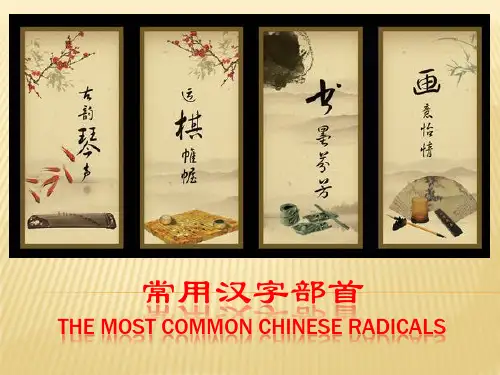

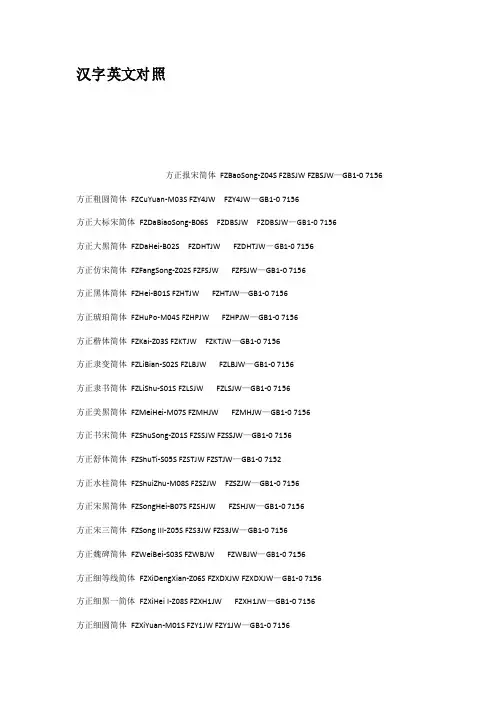
汉字英文对照方正报宋简体FZBaoSong-Z04S FZBSJW FZBSJW—GB1-0 7156方正粗圆简体FZCuYuan-M03S FZY4JW FZY4JW—GB1-07156方正大标宋简体FZDaBiaoSong-B06S FZDBSJW FZDBSJW—GB1-07156方正大黑简体FZDaHei-B02S FZDHTJW FZDHTJW—GB1-0 7156方正仿宋简体FZFangSong-Z02S FZFSJW FZFSJW—GB1-07156方正黑体简体FZHei-B01S FZHTJW FZHTJW—GB1-07156方正琥珀简体FZHuPo-M04S FZHPJW FZHPJW—GB1-07156方正楷体简体FZKai-Z03S FZKTJW FZKTJW—GB1-0 7156方正隶变简体FZLiBian-S02S FZLBJW FZLBJW—GB1-07156方正隶书简体FZLiShu-S01S FZLSJW FZLSJW—GB1-07156方正美黑简体FZMeiHei-M07S FZMHJW FZMHJW—GB1-07156方正书宋简体FZShuSong-Z01S FZSSJW FZSSJW—GB1-07156方正舒体简体FZShuTi-S05S FZSTJW FZSTJW—GB1-0 7152方正水柱简体FZShuiZhu-M08S FZSZJW FZSZJW—GB1-07156方正宋黑简体FZSongHei-B07S FZSHJW FZSHJW—GB1-07156方正宋三简体FZSong III-Z05S FZS3JW FZS3JW—GB1-07156方正魏碑简体FZWeiBei-S03S FZWBJW FZWBJW—GB1-0 7156方正细等线简体FZXiDengXian-Z06S FZXDXJW FZXDXJW—GB1-0 7156方正细黑一简体FZXiHei I-Z08S FZXH1JW FZXH1JW—GB1-07156方正细圆简体FZXiYuan-M01S FZY1JW FZY1JW—GB1-07156方正小标宋简体FZXiaoBiaoSong-B05S FZXBSJW FZXBSJW—GB1-07156方正行楷简体FZXingKai-S04S FZXKJW FZXKJW—GB1-0 7156方正姚体简体FZYaoTi-M06S FZYTJW FZYTJW—GB1-0 7156方正中等线简体FZZhongDengXian-Z07S FZZDXJW FZZDXJW—GB1-0 7156方正准圆简体FZZhunYuan-M02S FZY3JW FZY3JW—GB1-0 7156方正综艺简体FZZongYi-M05S FZZYJW FZZYJW—GB1-07156方正彩云简体FZCaiYun-M09S FZCYJW FZCYJW—GB1-0 7156方正隶二简体FZLiShu II-S06S FZL2JW FZL2JW—GB1-07156方正康体简体FZKangTi-S07S FZKANGJW FZKANGJW—GB1-0 7156方正超粗黑简体FZChaoCuHei-M10S FZCCHJW FZCCHJW—GB1-0 7156方正新报宋简体FZNew BaoSong-Z12S FZNBSJW FZNBSJW—GB1097156方正新舒体简体FZNew ShuTi-S08S FZNSTJW FZNSTJW—GB1-0 7156方正黄草简体FZHuangCao-S09S FZHCJW FZHCJW—GB1-06763方正少儿简体FZShaoEr-M11S FZSEJW FZSEJW—GB1-07156方正稚艺简体FZZhiYi-M12S FZZHYJW FZZHYJW—GB1-0 7156方正细珊瑚简体FZXiShanHu-M13S FZXSHJW FZXSHJW—GB1-07156方正粗宋简体FZCuSong-B09S FZCSJW FZCSJW—GB1-0 7156方正平和简体FZPingHe-S11S FZPHTJW FZPHTJW—GB1-0 7156方正华隶简体FZHuaLi-M14S FZHLJW FZHLJW—GB1-0 7156方正瘦金书简体FZShouJinShu-S10S FZSJSJW FZSJSJW—GB1-07156方正细倩简体FZXiQian-M15S FZXQJW FZXQJW—GB1-0 7156方正中倩简体FZZhongQian-M16S FZZQJW FZZQJW—GB1-0 7156方正粗倩简体FZCuQian-M17S FZCQJW FZCQJW—GB1-0 7156方正胖娃简体FZPangWa-M18S FZPWJW FZPWJW—GB1-07156方正宋一简体FZSongYi-Z13S FZSYJW FZSYJW—GB1-0 7156(繁体部分)中文字体名英文字体名文件名PS name 汉字数方正报宋繁体FZBaoSong-Z04T FZXLFW FZXLFW—GB1-0 6866方正彩云繁体FZCaiYun-M09T FZCYFW FZCYFW—GB1-06866方正超粗黑繁体FZChaoCuHei-M10T FZCCHFW FZCCHFW—GB1-0 6866方正粗黑繁体FZCuHei-B03T FZH4FW FZH4FW—GB1-06866方正粗圆繁体FZCuYuan-M03T FZY4FW FZY4FW—GB1-06866方正大标宋繁体FZDaBiaoSong-B06T FZDBSFW FZDBSFW—GB1-06866方正仿宋繁体FZFangSong-Z02T FZFSFW FZFSFW—GB1-06866方正黑体繁体FZHei-B01T FZHTFW FZHTFW—GB1-06866方正琥珀繁体FZHuPo-M04T FZHPFW FZHPFW—GB1-0 6866方正楷体繁体FZKai-Z03T FZKTFW FZKTFW—GB1-06866方正隶变繁体FZLiBian-S02T FZLBFW FZLBFW—GB1-0 6866方正平黑繁体FZPingHei-B04T FZPHFW FZPHFW—GB1-06866方正书宋繁体FZShuSong-Z01T FZSSFW FZSSFW—GB1-06866方正舒体繁体FZShuTi-S05T FZSTFW FZSTFW—GB1-0 6866方正魏碑繁体FZWeiBei-S03T FZWBFW FZWBFW—GB1-06866方正细黑一繁体FZXiHei I-Z08T FZXH1FW FZXH1FW—GB1-06866方正细圆繁体FZXiYuan-M01T FZY1FW FZY1FW—GB1-06866方正小标宋繁体FZXiaoBiaoSong-B05T FZXBSFW FZXBSFW—GB1-0 6866方正新书宋繁体FZNew ShuSong-Z10T FZXSSFW FZXSSFW—GB1-06866方正新秀丽繁体FZNew XiuLi-Z11T FZXXLFW FZXXLFW—GB1-06866方正行楷繁体FZXingKai-S04T FZXKFW FZXKFW—GB1-06866方正幼线繁体FZYouXian-Z09T FZYXFW FZYXFW—GB1-0 6866方正中楷繁体FZZhongKai-B08T FZZKFW FZZKFW—GB1-06866方正准圆繁体FZZhunYuan-M02T FZY3FW FZY3FW—GB1-0 6866方正综艺繁体FZZongYi-M05T FZZYFW FZZYFW—GB1-0 6866方正隶二繁体FZLiShu II-S06T FZL2FW FZL2FW—GB1-06866方正新舒体繁体FZNew ShuTi-S08T FZNSTFW FZNSTFW—GB1-06866方正康体繁体FZKangTi-S07T FZKANGFW FZKANGFW—GB1-0 6866方正水柱繁体FZShuiZhu-M08T FZSZFW FZSZFW—GB1-06866方正姚体繁体FZYaoTi-M06T FZYTFW FZYTFW—GB1-06866方正瘦金书繁体FZShouJinShu-S10T FZSJSFW FZSJSFW—GB1-06866方正少儿繁体FZShaoEr-M11T FZSEFW FZSEFW—GB1-06866方正稚艺繁体FZZhiYi-M12T FZZHYFW FZZHYFW—GB1-0 6866方正细珊瑚繁体FZXiShanHu-M13T FZXSHFW FZXSHFW—GB1-0 6866方正粗宋繁体FZCuSong-B09T FZCSFW FZCSFW—GB1-0 6866方正平和繁体FZPingHe-S11T FZPHTFW FZPHTFW—GB1-06866方正华隶繁体FZHuaLi-M14T FZHLFW FZHLFW—GB1-0 6866方正中等线繁体FZZhongDengXian-Z07T FZZDXFW FZZDXFW—GB1-06866方正细倩繁体FZXiQian-M15T FZXQFW FZXQFW—GB1-0 6866方正中倩繁体FZZhongQian-M16T FZZQFW FZZQFW—GB1-0 6866方正粗倩繁体FZCuQian-M17T FZCQFW FZCQFW—GB1-0 6866方正胖娃繁体FZPangWa-M18T FZPWFW FZPWFW—GB1-06866方正宋一繁体FZSongYi-Z13T FZSYFW FZSYFW—GB1-06866增加字体清单序号字体中文名字数国标编码西文名中文名PSName FileName1方正卡通简体2方正卡通繁体3方正艺黑简体4方正艺黑繁体7156FZKaTong-M19S方正卡通简体6866FZKaTong-M19T方正卡通繁体7156FZYiHei-M20S 方正艺黑简体6866FZYiHei-M20T 方正艺黑繁体FZKATJW--GB1-0FZKATJWFZKATFW--GB1-0 FZKATFWFZYHJW--GB1-0 FZYHJWFZYHFW--GB1-0FZYHFW5方正水黑简体6方正水黑繁体7156FZShuiHei-M21S 方正水黑简体6866FZShuiHei-M21T 方正水黑繁体FZSHHJW--GB1-0 FZSHHJWFZSHHFW--GB1-0FZSHHFW7方正古隶简体8方正古隶繁体7156FZGuLi-S12S 方正古隶简体6866FZGuLi-S12T 方正古隶繁体FZGLJW--GB1-0FZGLJWFZGLFW--GB1-0FZGLFW9 方正小篆体6866FZXiaoZhuanTi-S13T 方正小篆体FZXZTFW--GB1-0FZXZTFW10 方正幼线简体7156FZYouXian-Z09S 方正幼线简体FZYXJW--GB1-0FZYXJW11方正启体简体12方正启体繁体7156FZQiTi-S14S 方正启体简体6866FZQiTi-S14T 方正启体繁体FZQTJW--GB1-0 FZQTJWFZQTFW--GB1-0FZQTFW13 方正硬笔楷书简体7156FZYingBiKaiShu-S15S 方正硬笔楷书简体FZYBKSJW--GB1-0FZYBKSJW14方正硬笔楷书繁体6866 FZYingBiKaiShu-S15T方正硬笔楷书繁体FZYBKSFW--GB1-0 FZYBKSFW15 方正毡笔黑简体7156FZZhanBiHei-M22S 方正毡笔黑简体FZZBHJW--GB1-0FZZBHJW16 方正毡笔黑繁体6866FZZhanBiHei-M22T 方正毡笔黑繁体FZZBHFW--GB1-0FZZBHFW17方正硬笔行书简体7156 FZYingBiXingShu-S16S方正硬笔行书简体FZYBXSJW--GB1-0 FZYBXSJW18方正硬笔行书繁体6866 FZYingBiXingShu-S16T方正硬笔行书繁体FZYBXSFW--GB1-0 FZYBXSFW新增字体清单中文名西文名PS Name 文件名字数方正剪纸简体FZJianZhi-M23S FZJZJW—GB1-0 FZJZJW 7156方正剪纸繁体FZJianZhi-M23T FZJZFW—GB1-0 FZJZFW6866方正胖头鱼简体FZPangTouYu-M24S FZPTYJW—GB1-0FZPTYJW7156方正铁筋隶书简体FZTieJinLiShu-Z14S FZTJLSJW—GB1-0 FZTJLSJW 7156方正铁筋隶书繁体FZTieJinLiShu-Z14T FZTJLSFW—GB1-0 FZTJLSFW 6866方正北魏楷书简体FZBeiWeiKaiShu-Z15S FZBWKSJW—GB1-0 FZBWKSJW 7156方正北魏楷书繁体FZBeiWeiKaiShu-Z15T FZBWKSFW—GB1-0 FZBWKSFW 6866方正祥隶简体FZXiangLi-S17S FZXIANGLJW—GB1-0FZXIANGLJW7156方正祥隶繁体FZXiangLi-S17T FZXIANGLFW—GB1-0 FZXIANGLFW 6866方正粗活意简体FZCuHuoYi-M25S FZCHYJW—GB1-0FZCHYJW7156方正粗活意繁体FZCuHuoYi-M25T FZCHYFW—GB1-0 FZCHYFW 6866方正流行体简体FZLiuXingTi-M26S FZLXTJW—GB1-0 FZLXTJW 7156方正流行体繁体FZLiuXingTi-M26T FZLXTFW—GB1-0 FZLXTFW 6866方正宋黑繁体FZSongHei-B07T FZSHFW—GB1-0 FZSHFW6866方正大黑繁体FZDaHei-B02T FZDHTFW—GB1-0 FZDHTFW 6866方正隶书繁体FZLiShu-S01T FZLSFW—GB1-0 FZLSFW 6866汉仪字库中英文对照表汉仪超粗宋简=HYA0GJ汉仪超粗宋繁=HYA0GF 汉仪书宋一简=HYA1GJ汉仪书宋一繁=HYA1GF汉仪报宋简=HYA2GJ汉仪报宋繁=HYA2GF汉仪中宋简=HYA3GJ汉仪中宋繁=HYA3GF汉仪大宋简=HYA4GJ汉仪大宋繁=HYA4GF汉仪长宋简=HYA5GJ汉仪长宋繁=HYA5GF汉仪书宋二简=HYA6GJ汉仪书宋二繁=HYA6GF汉仪字典宋简=HYA7GJ汉仪字典宋繁=HYA7GF汉仪粗宋简=HYA9GJ汉仪粗宋繁=HYA9GF汉仪超粗黑简=HYB0GJ汉仪超粗黑繁=HYB0GF汉仪中黑简=HYB1GJ汉仪大黑简=HYB2GJ汉仪大黑繁=HYB2GF 汉仪长美黑简=HYB3GJ 汉仪长美黑繁=HYB3GF 汉仪方叠体简=HYB4GJ 汉仪方叠体繁=HYB4GF 汉仪醒示体简=HYB5GJ 汉仪醒示体繁=HYB5GF 汉仪长艺体简=HYB6GJ 汉仪长艺体繁=HYB6GF 汉仪双线体简=HYB7GJ 汉仪双线体繁=HYB7GF 汉仪圆叠体简=HYB8GJ 汉仪圆叠体繁=HYB8GF 汉仪粗黑简=HYB9GJ汉仪粗黑繁=HYB9GF 汉仪楷体简=HYC1GJ汉仪楷体繁=HYC1GF 汉仪中楷简=HYC3GJ汉仪仿宋简=HYD1GJ 汉仪仿宋繁=HYD1GF 汉仪粗仿宋简=HYD4GJ汉仪细圆繁=HYE1GF汉仪细中圆简=HYE2GJ汉仪细中圆繁=HYE2GF 汉仪中圆简=HYE3GJ汉仪中圆繁=HYE3GF汉仪粗圆简=HYE4GJ汉仪粗圆繁=HYE4GF汉仪超粗圆简=HYE0GJ汉仪大隶书简=HYF1GJ汉仪大隶书繁=HYF1GF 汉仪小隶书简=HYF2GJ汉仪小隶书繁=HYF2GF 汉仪中隶书简=HYF3GJ汉仪中隶书繁=HYF3GF 汉仪方隶简=HYF0GJ汉仪特细等线简=HYG6GJ 汉仪细等线简=HYG1GJ 汉仪细等线繁=HYG1GF 汉仪中等线简=HYG2GJ 汉仪中等线繁=HYG2GF 汉仪魏碑简=HYH1GJ汉仪魏碑繁=HYH1GF汉仪书魂体简=HYH3GJ 汉仪南宫体简=HYH4GJ汉仪行楷繁=HYI1GF汉仪细行楷简=HYI2GJ 汉仪瘦金书简=HYI3GJ 汉仪瘦金书繁=HYI3GF 汉仪综艺体简=HYK1GJ 汉仪综艺体繁=HYK1GF 汉仪菱心体简=HYK2GJ 汉仪彩云体简=HYL1GJ 汉仪彩云体繁=HYL1GF 汉仪咪咪体简=HYM1GJ 汉仪咪咪体繁=HYM1GF 汉仪黑咪体简=HYM2GJ 汉仪黑咪体繁=HYM2GF 汉仪舒同体简=HYN1GJ 汉仪舒同体繁=HYN1GF 汉仪琥珀体简=HYO1GJ 汉仪琥珀体繁=HYO1GF汉仪水滴体简=HYP1GJ 汉仪水滴体繁=HYP1GF 汉仪竹节体简=HYQ1GJ 汉仪竹节体繁=HYQ1GF 汉仪火柴体简=HYQ2GJ汉仪凌波体繁=HYR1GF汉仪漫步体简=HYR2GJ汉仪漫步体繁=HYR2GF汉仪颜楷繁=HYX4GF汉仪秀英体简=HYY1GJ汉仪秀英体繁=HYY1GF汉仪雁翎体简=HYF4GJ汉仪橄榄体简=HYX1GJ汉仪橄榄体繁=HYX1GF汉仪陈频破体简=HYF5GJ汉仪花蝶体简=HYF9GJ汉仪丫丫体简=HYG3GJ汉仪清韵体简=HYG4GJ汉仪雪君体简=HYI4GJ汉仪雪君体繁=HYI4GF 汉仪娃娃篆简=HYJ2GJ汉仪篆书繁=HYJ1GF汉仪粗篆繁=HYJ3GF汉仪神工体简=HYH2GJ汉仪柏青体简=HYJ4GJ汉仪海韵体简=HYK3GJ汉仪彩蝶体简=HYK5GJ汉仪哈哈体简=HYM4GJ汉仪白棋体简=HYM5GJ汉仪黑棋体简=HYM6GJ汉仪水波体简=HYM7GJ汉仪蝶语体简=HYN3GJ汉仪太极体简=HYO3GJ汉仪黛玉体简=HYR3GJ汉仪立黑简=HYT4GJ汉仪萝卜体简=HYY2GJ汉仪嘟嘟体简=HYY4GJ汉仪家书简=HYD2GJ汉仪家书繁=HYD2GF汉仪雪峰体简=HYO2GJ汉仪雪峰体繁=HYO2GF29000文鼎粗钢笔行楷PensinkaiEG-Bold-GB GPSK00B 29001文鼎中钢笔行楷PensinkaiEG-Medium-GB GPSK00M 29002文鼎细钢笔行楷PensinkaiEG-Light-GB GPSK00L 29003文鼎中特广告体Pop3EG-Extra-GB GPOP03E 29004文鼎誰的字体SheideEG-Medium-GB GSHE00M 29005文鼎习字体YankaigungEG-Ultra-GB GYKG00U 29006文鼎香肠体ShiangchangEG-Bold-GB GSHC00B29007文鼎石头体StoneEG-Extra-GB GSTO00E29008文鼎行楷碑体SingkaibeiEG-Bold-GB GSKB00B29009文鼎潇洒体ShiansaEG-Medium-GB GSHS00M 29010文鼎花瓣体HuabanEG-Ultra-GB GHUB00U29011文鼎霹雳体PiliEG-Ultra-GB GPIL00U29012文鼎妞妞体NiuniuEG-Bold-GB GNIU00B29013文鼎荆棘体JingjiEG-Medium-GB GJIJ00M29014文鼎胡子体HutzEG-Extra-GB GHUT00E29015文鼎竹子体JutzEG-Medium-GB GJUT00M29016文鼎贱狗体JiangouEG-Bold-GB GJIA00B29017文鼎彈簧体TanhuangEG-Bold-GB GTAN00B29018文鼎齿轮体ChrluenEG-Medium-GB GCHR00M 29019文鼎圆立体YuanliEG-Bold-GB GYUL00B29020文鼎淹水体YanshueiEG-Extra-GB GYAN00E 29021文鼎雕刻体DiaukeEG-Bold-GB GDIK00B29022文鼎火柴体HuochaiEG-Bold-GB GHUO00B29023文鼎水管体ShueiguanEG-Bold-GB GSHG00B 29024文鼎POP-4Pop4EG-Bold-GB GPOP05B 29025文鼎荊棘体繁JingjiEG-Medium-T-GB TJIJ00M 29026文鼎贱狗体繁JiangouEG-Bold-T-GB TJIA00B 29027文鼎齒轮体繁ChrluenEG-Medium-T-GB TCHR00M 29028文鼎雕刻体繁DiaukeEG-Bold-T-GB TDIK00B 29029文鼎誰的字体繁SheideEG-Medium-T-GB TSHE00M。
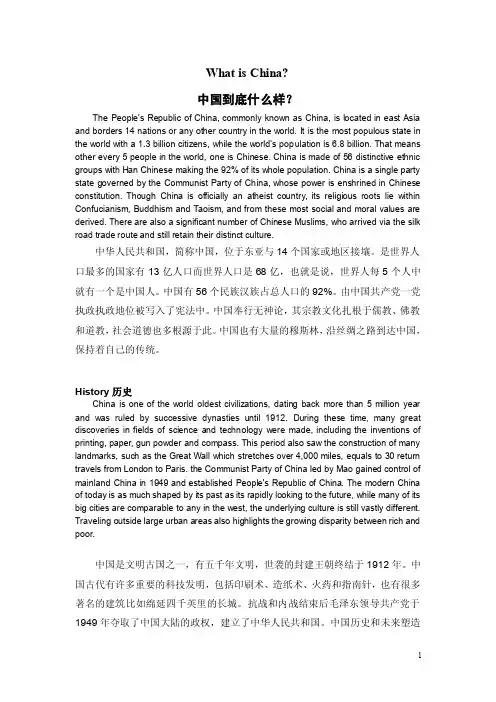
What is China?中国到底什么样?The People's Republic of China, commonly known as China, is located in east Asia and borders 14 nations or any other country in the world. It is the most populous state in the world with a 1.3 billion citizens, while the world's population is 6.8 billion. That means other every 5 people in the world, one is Chinese. China is made of 56 distinctive ethnic groups with Han Chinese making the 92% of its whole population. China is a single party state governed by the Communist Party of China, whose power is enshrined in Chinese constitution. Though China is officially an atheist country, its religious roots lie within Confucianism, Buddhism and Taoism, and from these most social and moral values are derived. There are also a significant number of Chinese Muslims, who arrived via the silk road trade route and still retain their distinct culture.中华人民共和国,简称中国,位于东亚与14个国家或地区接壤。

100个中国传统文化词汇的英文翻译翻译元宵节元宵节 Lantern Fes val 刺绣刺绣Embroidery 重阳节重阳节Double-Ninth Fes val 清明节清明节Tomb sweeping day 剪纸剪纸Paper Cu ng 书 法Calligraphy 对联对联 (Spring Fes val) Couplets 象形文字 Pictograms/Pictographic Characters雄黄酒雄黄酒Realgar wine 四合院四合院Siheyuan/Quadrangle 战国战国Warring States 风水风水Fengshui/Geoman c Omen 昆曲昆曲Kunqu Opera 长 城 The Great Wall 集体舞集体舞Group Dance 黄土高原黄土高原Loess Plateau 红臼喜事红臼喜事 Weddings and Funerals中秋节中秋节Mid-Autumn Day 花鼓戏花鼓戏Flower Drum Song 儒家文化儒家文化Confucian Culture 中国结中国结Chinese kno ng 古装片古装片Costume Drama 武打片武打片 Chinese Swordplay Movie元宵元宵 Tangyuan/Sweet Rice Dumpling 越剧越剧 Yue Opera 火锅火锅Hot Pot 江南江南 South Regions of the Yangtze River 谜语谜语Riddle 《诗经》《诗经》 The Book of Songs 《史记》《史记》Historical Records/Records of the Grand Historian《红楼梦》《红楼梦》 A Dream of Red Mansions《西游记》《西游记》 The Journey to the West除夕除夕Chinese New Year’s Eve/Eve of the Spring Fes val 针灸针灸Acupuncture 唐三彩唐三彩 Tri-color Po ery of the TangDynasty/ The Tang Tri-colored po ery 孔子孔子 Confucius 偏旁偏旁 Radical 孟子孟子Mencius 亭/ 阁 Pavilion/ A c 黄梅戏黄梅戏Huangmei opera 火 药 Gunpowder 农历农历Lunar Calendar 印/ 玺 Seal/Stamp 腊 八 节 The laba Rice Porridge Fes val京 剧 Beijing Opera/Peking Opera秦腔秦腔Crying of Qin People/Qin Opera 太极拳太极拳TaiChi 《本草纲目》《本草纲目》 Compendium of Materia Medica天坛天坛Altar of Heaven in Beijing 小吃摊小吃摊Snack Bar/Snack Stand 红双喜红双喜Double Happiness 文房四宝(笔墨纸砚)笔墨纸砚) The Four Treasure of the Study (Brush,Inks ck,Paper,and Inkstone ) 春卷春卷Spring Roll(s) 莲藕莲藕Lotus Root 罗盘罗盘Luopan/ compass 故宫博物院故宫博物院The Palace Museum 相声相声Cross-talk/Comic Dialogue 五行五行Five Phases 北京烤鸭北京烤鸭Beijing Roast Duck 《桃花扇》《桃花扇》 The Peach Blossom Fan木偶戏木偶戏Puppet Show 敦煌莫高窟敦煌莫高窟Mogao Caves电视小品电视小品TV Sketch/TV Skit 甲骨文甲骨文Oracle Bone Inscrip ons 古筝古筝Chinese Zither 杂技杂技acroba cs 门当户对门当户对 Perfect Match/Exact Match《水浒》《水浒》 Water Margin/Outlaws of the Marsh除夕除夕Chinese New Year's Eve 国子监国子监Imperial Academy 兵马俑兵马俑 Co a Warriors/ Terraco a Army 旗袍旗袍Cheongsam 中国古代四大发明中国古代四大发明the four great inven ons of ancient China (火药gunpowder 印刷术prin ng 造纸术paper-making 指南针the compass ) 泼水节泼水节 Water-Splashing Day 馄饨馄饨Wonton 花卷花卷Steamed twisted rolls 羊肉泡馍羊肉泡馍Pita Bread Soaked in Lamb Soup冰糖葫芦冰糖葫芦 A s ck of sugar-coated haws (or apples,etc.) 八宝饭八宝饭 Eight-treasure rice pudding粉丝粉丝Glass Noodles 豆腐脑豆腐脑 Jellied bean curd 小品小品Wi y Skits 孝顺孝顺To show filial obedience 武术武术 Wushu(Chinese Mar al Arts)宣纸宣纸Rice Paper 陶器陶器po ery/earthenware 佛教佛教Buddhism 中庸中庸 The way of medium(Golden Means) 爆竹爆竹firecracker 东坡肉东坡肉Dongpo Pork 中山陵中山陵 The Sun Yat-sen Mausoleum秦淮河秦淮河Qinhuai River 玄武湖玄武湖Xuanwu Lake夫子庙夫子庙The Confucian Temple 鸭血粉丝鸭血粉丝Duck blood fans 盐水鸭盐水鸭 Yanshuiya, or salted and baked duck 大煮干丝大煮干丝Gansi 小笼包小笼包Steamed buns 明孝陵明孝陵Ming Tomb 云锦云锦 Nanjing brocade。

汉典常用字表(中英文实用版)Title: Common Characters List in Han DictionaryTitle: 汉典常用字表In the Han Dictionary, the common characters list is a valuable resource for those who are learning Chinese.It provides a comprehensive list of the most frequently used characters in the Chinese language, which is essential for improving language proficiency.在汉典中,常用字表对于学习中文的人来说是一个宝贵的资源。
它提供了最常用汉字的全面列表,对于提高语言熟练度至关重要。
The common characters list in the Han Dictionary is organized in order of frequency, making it easy for learners to focus on the most commonly used characters first.This can help to maximize learning efficiency and make progress in mastering the Chinese language.汉典中的常用字表按照频率排序,便于学习者首先关注最常用的汉字。
这有助于最大化学习效率,掌握汉语。
Additionally, the Han Dictionary provides additional information for each character, such as its meaning, pronunciation, and stroke order.This can be very helpful for learners who are trying to improve their ability to read and write Chinese characters.此外,汉典还为每个汉字提供了额外的信息,如它的意义、发音和笔画顺序。
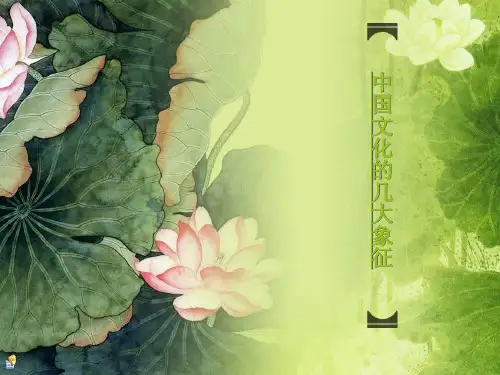

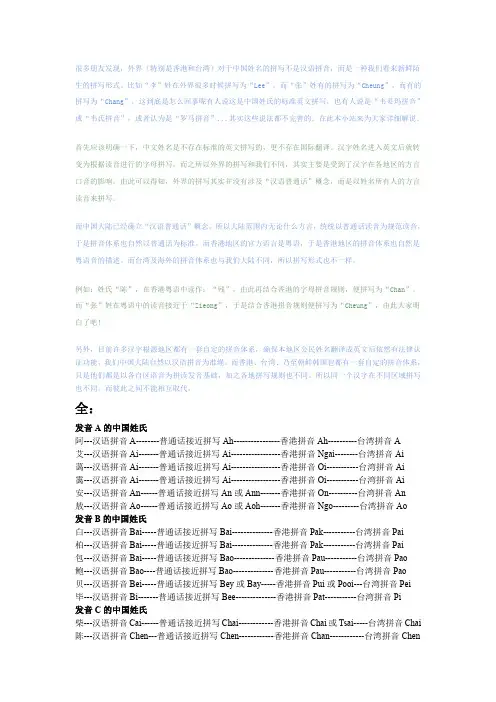
很多朋友发现,外界(特别是香港和台湾)对于中国姓名的拼写不是汉语拼音,而是一种我们看来新鲜陌生的拼写形式。
比如“李”姓在外界很多时候拼写为“Lee”。
而“张”姓有的拼写为“Cheung”,而有的拼写为“Chang”,这到底是怎么回事呢有人说这是中国姓氏的标准英文拼写,也有人说是“韦妥玛拼音”或“韦氏拼音”,或者认为是“罗马拼音”...其实这些说法都不完善的。
在此本小站来为大家详细解说。
首先应该明确一下,中文姓名是不存在标准的英文拼写的,更不存在国际翻译。
汉字姓名进入英文后就转变为根据读音进行的字母拼写。
而之所以外界的拼写和我们不同,其实主要是受到了汉字在各地区的方言口音的影响。
由此可以得知,外界的拼写其实并没有涉及“汉语普通话”概念,而是以姓名所有人的方言读音来拼写。
而中国大陆已经确立“汉语普通话”概念,所以大陆范围内无论什么方言,统统以普通话读音为规范读音,于是拼音体系也自然以普通话为标准。
而香港地区的官方语言是粤语,于是香港地区的拼音体系也自然是粤语音的描述。
而台湾及海外的拼音体系也与我们大陆不同,所以拼写形式也不一样。
例如:姓氏“陈”,在香港粤语中读作:“残”,由此再结合香港的字母拼音规则,便拼写为“Chan”。
而“张”姓在粤语中的读音接近于“Zieong”,于是结合香港拼音规则便拼写为“Cheung”,由此大家明白了吧!另外,目前许多汉字根源地区都有一套自定的拼音体系,确保本地区公民姓名翻译成英文后依然有法律认证功能,我们中国大陆自然以汉语拼音为准绳。
而香港、台湾、乃至朝鲜韩国也都有一套自定的拼音体系,只是他们都是以各自区语音为拼读发音基础,加之各地拼写规则也不同。
所以同一个汉字在不同区域拼写也不同。
而彼此之间不能相互取代。
全:发音A的中国姓氏阿---汉语拼音A--------普通话接近拼写Ah----------------香港拼音Ah----------台湾拼音A艾---汉语拼音Ai-------普通话接近拼写Ai-----------------香港拼音Ngai--------台湾拼音Ai蔼---汉语拼音Ai-------普通话接近拼写Ai-----------------香港拼音Oi-----------台湾拼音Ai霭---汉语拼音Ai-------普通话接近拼写Ai-----------------香港拼音Oi-----------台湾拼音Ai安---汉语拼音An------普通话接近拼写An或Ann-------香港拼音On----------台湾拼音An敖---汉语拼音Ao------普通话接近拼写Ao或Aoh-------香港拼音Ngo---------台湾拼音Ao发音B的中国姓氏白---汉语拼音Bai-----普通话接近拼写Bai--------------香港拼音Pak-----------台湾拼音Pai柏---汉语拼音Bai-----普通话接近拼写Bai--------------香港拼音Pak-----------台湾拼音Pai包---汉语拼音Bai-----普通话接近拼写Bao--------------香港拼音Pau-----------台湾拼音Pao鲍---汉语拼音Bao----普通话接近拼写Bao--------------香港拼音Pau-----------台湾拼音Pao贝---汉语拼音Bei-----普通话接近拼写Bey或Bay-----香港拼音Pui或Pooi---台湾拼音Pei毕---汉语拼音Bi-------普通话接近拼写Bee--------------香港拼音Pat-----------台湾拼音Pi发音C的中国姓氏柴---汉语拼音Cai------普通话接近拼写Chai------------香港拼音Chai或Tsai-----台湾拼音Chai 陈---汉语拼音Chen---普通话接近拼写Chen------------香港拼音Chan------------台湾拼音Chen成---汉语拼音Cheng-普通话接近拼写Chung-----------香港拼音Sing----------台湾拼音Cheng 程---汉语拼音Cheng-普通话接近拼写Chung--------香港拼音Ching------------台湾拼音Cheng 崔---汉语拼音Cui------普通话接近拼写Chooi------------香港拼音Chui或Tsui----台湾拼音Tsu 常---汉语拼音Chang-普通话接近拼写Chang--------香港拼音Seung-----------台湾拼音Chang 长---汉语拼音Chang-普通话接近拼写Chang--------香港拼音Cheung---------台湾拼音Chang 丛---汉语拼音Cong---普通话接近拼写Choong---香港拼音Chung或Tsung--台湾拼音Tsung 楚---汉语拼音Chu-----普通话接近拼写Choo----------香港拼音Cho----------------台湾拼音Chu 发音D的中国姓氏戴---汉语拼音Dai-----普通话接近拼写Dai------------------香港拼音Tai-------------台湾拼音Tai 代---汉语拼音Dai-----普通话接近拼写Dai------------------香港拼音Toi-------------台湾拼音Tai 党---汉语拼音Dang--普通话接近拼写Dang---------------香港拼音Tong-----------台湾拼音Tang 邓---汉语拼音Dang--普通话接近拼写Tung----------------香港拼音Tang----------台湾拼音Teng 狄---汉语拼音Di------普通话接近拼写Dee------------------香港拼音Tik-------------台湾拼音Ti 丁---汉语拼音Ding---普通话接近拼写Ding----------------香港拼音Ting------------台湾拼音Ting 窦---汉语拼音Dou----普通话接近拼写Doh-----------------香港拼音Tau------------台湾拼音Tou 董---汉语拼音Dong--普通话接近拼写Doong-------------香港拼音Tung-----------台湾拼音Tung 杜---汉语拼音Du------普通话接近拼写Doo----------------香港拼音To---------------台湾拼音Tu 东方-汉语拼音DongFang-普通话英文DoongFang-香港拼音TungFong-台湾拼音TungFang 东郭-汉语拼音DongGuo--普通话英文DoongKwor-香港拼音TungKwok-台湾拼音TungKuo 发音E的中国姓氏鄂--------汉语拼音E----------普通话接近拼写Or-------------香港拼音Ngok------------台湾拼音O 恩--------汉语拼音En--------普通话接近拼写En-------------香港拼音Yan-------------台湾拼音En 发音F的中国姓氏范--------汉语拼音Fan------普通话接近拼写Fan-----------香港拼音Fan--------------台湾拼音Fan 樊--------汉语拼音Fan------普通话接近拼写Fan-----------香港拼音Fan--------------台湾拼音Fan 方--------汉语拼音Fang----普通话接近拼写Fang---------香港拼音Fong------------台湾拼音Fang 房--------汉语拼音Fang----普通话接近拼写Fang---------香港拼音Fong------------台湾拼音Fang 费--------汉语拼音Fei-------普通话接近拼写Fay-----------香港拼音Fai---------------台湾拼音Fei 封--------汉语拼音Feng----普通话接近拼写Fung--------香港拼音Fung------------台湾拼音Feng 凡--------汉语拼音Fan------普通话接近拼写Fan-----------香港拼音Fan--------------台湾拼音Fan 冯--------汉语拼音Feng----普通话接近拼写Fung--------香港拼音Fung------------台湾拼音Feng 傅--------汉语拼音Fu--------普通话接近拼写Foo----------香港拼音Fu或Foo-------台湾拼音Fu 付--------汉语拼音Fu--------普通话接近拼写Foo----------香港拼音Fu或Foo-------台湾拼音Fu 符--------汉语拼音Fu--------普通话接近拼写Foo----------香港拼音Fu或Foo-------台湾拼音Fu 发音G的中国姓氏甘-----汉语拼音Gan------普通话接近拼写Kan-----------香港拼音Kam------台湾拼音Kan高-----汉语拼音Gao------普通话接近拼写Kao-----------香港拼音Ko---------台湾拼音Kao葛-----汉语拼音Ge--------普通话接近拼写Kor------------香港拼音Kot-------台湾拼音Ko庚-----汉语拼音Geng----普通话接近拼写Kung----------香港拼音Kang-----台湾拼音Keng耿-----汉语拼音Geng----普通话接近拼写Kung----------香港拼音Kang-----台湾拼音Keng龚-----汉语拼音Gong----普通话接近拼写Koong--------香港拼音Kung-----台湾拼音Kung公-----汉语拼音Gong----普通话接近拼写Koong--------香港拼音Kung-----台湾拼音Kung宫-----汉语拼音Gong----普通话接近拼写Koong--------香港拼音Kung-----台湾拼音Kung巩-----汉语拼音Gong----普通话接近拼写Koong--------香港拼音Kung-----台湾拼音Kung古-----汉语拼音Gu--------普通话接近拼写Koo或Goo--香港拼音Ku---------台湾拼音Ku顾-----汉语拼音Gu--------普通话接近拼写Koo或Goo--香港拼音Ku---------台湾拼音Ku关-----汉语拼音Guan----普通话接近拼写Kwan----------香港拼音Kwan----台湾拼音Kuan郭-----汉语拼音Guo------普通话接近拼写Kwor-----------香港拼音Kwok----台湾拼音Kuo苟-----汉语拼音Gou------普通话接近拼写Koh------香港拼音Kau或Kaw---台湾拼音Kou发音H的中国姓氏哈-----汉语拼音Ha--------普通话接近拼写Hah-----------香港拼音Hah------------台湾拼音Ha 海-----汉语拼音Hai-------普通话接近拼写Hai------------香港拼音Hoi-------------台湾拼音Hai 韩-----汉语拼音Han------普通话接近拼写Han-----------香港拼音Hon------------台湾拼音Han 郝-----汉语拼音Hao------普通话接近拼写Hao-----------香港拼音Kok------------台湾拼音Hao 何-----汉语拼音He--------普通话接近拼写Hor-----------香港拼音Ho---------------台湾拼音Ho 贺-----汉语拼音He--------普通话接近拼写Hor-----------香港拼音Ho---------------台湾拼音Ho 洪-----汉语拼音Hong----普通话接近拼写Hoong--------香港拼音Hung-----------台湾拼音Hung 侯-----汉语拼音Hou------普通话接近拼写Hoh-----------香港拼音Hau或Haw----台湾拼音Hou 胡-----汉语拼音Hu--------普通话接近拼写Hoo-----------香港拼音Wu或Woo----台湾拼音Hu 扈-----汉语拼音Hu--------普通话接近拼写Hoo-----------香港拼音Wu或Woo----台湾拼音Hu 华-----汉语拼音Hua------普通话接近拼写Hwa或Hwah---香港拼音Wah--------台湾拼音Hua 黄-----汉语拼音Huang---普通话接近拼写Hwang-------香港拼音Wong----------台湾拼音Huang 霍-----汉语拼音Huo------普通话接近拼写Hwor----------香港拼音Fok-------------台湾拼音Huo 火-----汉语拼音Huo------普通话接近拼写Hwor----------香港拼音Fo---------------台湾拼音Huo 回-----汉语拼音Hui-------普通话接近拼写Hooi-----------香港拼音Wui或Wooi--台湾拼音Hui 呼延-汉语拼音HuYan--普通话接近拼写HooYan-----香港拼音FuYin----------台湾拼音HuYen 发音J的中国姓氏贾-----汉语拼音Jia--------普通话接近拼写Jia或Jiah----香港拼音Kar--------------台湾拼音Chia 姬-----汉语拼音Ji----------普通话接近拼写Jee------------香港拼音Kei---------------台湾拼音Chi 吉-----汉语拼音Ji----------普通话接近拼写Jee------------香港拼音Kat---------------台湾拼音Chi 纪-----汉语拼音Ji----------普通话接近拼写Jee------------香港拼音Kei---------------台湾拼音Chi 金-----汉语拼音Jin--------普通话接近拼写Jinn-----------香港拼音Kam-------------台湾拼音Chin 靳-----汉语拼音Jin--------普通话接近拼写Jinn----------香港拼音Kan--------------台湾拼音Chin 江-----汉语拼音Jiang----普通话接近拼写Jiang--------香港拼音Kong------------台湾拼音Chiang 姜-----汉语拼音Jiang----普通话接近拼写Jiang--------香港拼音Keung----------台湾拼音Chiang 蒋-----汉语拼音Jiang----普通话接近拼写Jiang--------香港拼音Cheung--------台湾拼音Chiang 景-----汉语拼音Jing------普通话接近拼写Jing----------香港拼音King------------台湾拼音Ching 菁-----汉语拼音Jing------普通话接近拼写Jing-----------香港拼音Ching----------台湾拼音Ching 鞠-----汉语拼音Ju--------普通话接近拼写Ju---------------香港拼音Kuk-------------台湾拼音Chu 发音K的中国姓氏康-----汉语拼音Kang----普通话接近拼写Kang----------香港拼音Hong------------台湾拼音Kang 柯-----汉语拼音Ke-------普通话接近拼写Kor-------------香港拼音Or----------------台湾拼音Ko 孔-----汉语拼音Kong----普通话接近拼写Koong--------香港拼音Hung------------台湾拼音Kung 寇-----汉语拼音Kou------普通话接近拼写Ko或Koh----香港拼音Kau或Kaw----台湾拼音Kou 蒯-----汉语拼音Kuai-----普通话接近拼写Kwai----------香港拼音Kwai------------台湾拼音Kuai 邝-----汉语拼音Kuang--普通话接近拼写Kwang-------香港拼音Kwong---------台湾拼音Kuang 发音L的中国姓氏凌-----汉语拼音Ling-----普通话接近拼写Ling-----------香港拼音Ling-------------台湾拼音Ling刘-----汉语拼音Liu-------普通话接近拼写Liu-------------香港拼音Lau---------------台湾拼音Liu 柳-----汉语拼音Liu-------普通话接近拼写Liu-------------香港拼音Lau---------------台湾拼音Liu 龙-----汉语拼音Long----普通话接近拼写Loong---------香港拼音Lung------------台湾拼音Lung 娄-----汉语拼音Lou------普通话接近拼写Lo或Loh------香港拼音Lau-------------台湾拼音Lou 卢-----汉语拼音Lu-------普通话接近拼写Lu或Lew------香港拼音Lo----------------台湾拼音Lu 鲁-----汉语拼音Lu-------普通话接近拼写Lu或Lew------香港拼音Lo----------------台湾拼音Lu 陆-----汉语拼音Lu-------普通话接近拼写Lu或Lew-----香港拼音Luk或Look----台湾拼音Lu 罗-----汉语拼音Luo-----普通话接近拼写Lwor------------香港拼音Lo-----------------台湾拼音Lo 骆-----汉语拼音Luo-----普通话接近拼写Lwor------------香港拼音Lok---------------台湾拼音Lo 吕-----汉语拼音Lu-------普通话接近拼写Lu---------------香港拼音Lui----------------台湾拼音Lu 赖-----汉语拼音Lai------普通话接近拼写Lai--------------香港拼音Lai----------------台湾拼音Lai 蓝-----汉语拼音Lan-----普通话接近拼写Lan-------------香港拼音Lam--------------台湾拼音Lan 郎-----汉语拼音Lang---普通话接近拼写Lang或Long--香港拼音Long------------台湾拼音Lang 勒-----汉语拼音Le-------普通话接近拼写Lor--------------香港拼音Lak---------------台湾拼音Lo 冷-----汉语拼音Leng---普通话接近拼写Lung------------香港拼音Lang------------台湾拼音Leng 李-----汉语拼音Li--------普通话接近拼写Lee------------香港拼音Lee或Lei--------台湾拼音Li 黎-----汉语拼音Li--------普通话接近拼写Lee-------------香港拼音Lai----------------台湾拼音Li 雷-----汉语拼音Lei------普通话接近拼写Ley或Lei------香港拼音Lui---------------台湾拼音Lei 连-----汉语拼音Lian----普通话接近拼写Lian----------香港拼音Lin----------------台湾拼音Lien 梁-----汉语拼音Liang--普通话接近拼写Liang----------香港拼音Leung-----------台湾拼音Liang 林-----汉语拼音Lin------普通话接近拼写Lin或Linn或Lynn--香港拼音Lam------台湾拼音Lin 栾-----汉语拼音Luan---普通话接近拼写Lwan------------香港拼音Luen-----------台湾拼音Luan 发音M的中国姓氏马------汉语拼音Ma-------普通话接近拼写Mah或Mar-----香港拼音Ma-----------台湾拼音Ma 满------汉语拼音Man-----普通话接近拼写Man-------------香港拼音Moon-------台湾拼音Man 毛------汉语拼音Mao-----普通话接近拼写Mao-------------香港拼音Mo-----------台湾拼音Mao 门------汉语拼音Men-----普通话接近拼写Mun-------------香港拼音Moon--------台湾拼音Men 蒙------汉语拼音Meng---普通话接近拼写Mung----------香港拼音Mung--------台湾拼音Meng 孟------汉语拼音Meng---普通话接近拼写Mung----------香港拼音Mang--------台湾拼音Meng 梦------汉语拼音Meng---普通话接近拼写Mung----------香港拼音Mung--------台湾拼音Meng 米------汉语拼音Mi--------普通话接近拼写Mee-----------香港拼音Mai-----------台湾拼音Mi 莫------汉语拼音Mo-------通话接近拼写Mor---------------香港拼音Mok----------台湾拼音Mo 穆------汉语拼音Mu-------普通话接近拼写Moo------------香港拼音Mook--------台湾拼音Mu 牟------汉语拼音Mou------普通话接近拼写Moh-----------香港拼音Mau----------台湾拼音Mou 苗------汉语拼音Miao-----普通话接近拼写Miao---------香港拼音Miu-----------台湾拼音Miao 梅-----汉语拼音Mei-------普通话接近拼写May------------香港拼音Mui-----------台湾拼音Mei 慕容--汉语拼音MuRong--普通话英文MooRoong-香港拼音MouYung--台湾拼音MuJung发音N的中国姓氏那-----汉语拼音Na--------普通话接近拼写Nah或Naa------香港拼音Nah--------台湾拼音Na 能-----汉语拼音Neng-----普通话接近拼写Nung-------------香港拼音Nang------台湾拼音Neng 南-----汉语拼音Nan------普通话接近拼写Nan---------------香港拼音Nam-------台湾拼音Nan 牛-----汉语拼音Niu-------普通话接近拼写New---------------香港拼音Ngau------台湾拼音Niu 倪-----汉语拼音Ni---------普通话接近拼写Nee---------------香港拼音Ngai-------台湾拼音Ni宁-----汉语拼音Ning-----普通话接近拼写Ning---------------香港拼音Ning-------台湾拼音Ning 年-----汉语拼音Nian-----普通话接近拼写Nian---------------香港拼音Nin---------台湾拼音Nien 农-----汉语拼音Nong----普通话接近拼写Noong------------香港拼音Nung------台湾拼音Nung 南宫--汉语拼音NanGong--普通话拼写NanKoong--香港拼音NamKung--台湾拼音NanKung 发音O的中国姓氏区------汉语拼音Ou---------普通话接近拼写Oh--------------香港拼音Au或Aw----台湾拼音Ou 欧阳---汉语拼音OuYang--普通话英文OhYang----香港拼音AuYeung----台湾拼音OuYang发音P的中国姓氏潘------汉语拼音Pan--------普通话接近拼写Pan--------------香港拼音Poon---------台湾拼音Pan 庞------汉语拼音Pang------普通话接近拼写Pang------------香港拼音Pong---------台湾拼音Pang 彭------汉语拼音Peng------普通话接近拼写Pung------------香港拼音Pang---------台湾拼音Peng 皮------汉语拼音Pi-----------普通话接近拼写Pea--------------香港拼音Pei-----------台湾拼音Pi 平------汉语拼音Ping-------普通话接近拼写Ping-------------香港拼音Ping---------台湾拼音Ping 蒲------汉语拼音Pu----------普通话接近拼写Poo--------------香港拼音Po------------台湾拼音Pu 发音Q的中国姓氏祁------汉语拼音Qi-----------普通话接近拼写Chee-----------香港拼音Kei-----------台湾拼音Chi 钱------汉语拼音Qian--------普通话接近拼写Chian---------香港拼音Chin---------台湾拼音Mien 乔------汉语拼音Qiao--------普通话接近拼写Cheoh---------香港拼音Kiu--------台湾拼音Chiao 秦------汉语拼音Qin--------普通话接近拼写Chin或Chinn--香港拼音Chun-------台湾拼音Chin 邱------汉语拼音Qiu--------普通话接近拼写Chiw-----------香港拼音Yau----------台湾拼音Chiu 屈------汉语拼音Qu----------普通话接近拼写Chu-------------香港拼音Wat---------台湾拼音Chu 曲------汉语拼音Qu----------普通话接近拼写Chu-------------香港拼音Kook-------台湾拼音Chu 瞿------汉语拼音Qu----------普通话接近拼写Chu------------香港拼音Kui-----------台湾拼音Chu 权------汉语拼音Quan------普通话接近拼写Chuien--------香港拼音Kuen-------台湾拼音Chuan 全------汉语拼音Quan----普通话接近拼写Chuien---香港拼音Chuen或Tsuen--台湾拼音Chuan 发音R的中国姓氏冉------汉语拼音Ran---------普通话接近拼写Ran--------------香港拼音Yim---------台湾拼音Jan 任------汉语拼音Ren---------普通话接近拼写Ren--------------香港拼音Yam--------台湾拼音Jen 荣------汉语拼音Rong-------普通话接近拼写Roong-----------香港拼音Wing-----台湾拼音Jung 容------汉语拼音Rong-------普通话接近拼写Roong-----------香港拼音Yung-----台湾拼音Jung 阮------汉语拼音Ruan-------普通话接近拼写Rwan------------香港拼音Yuen-----台湾拼音Juan 芮------汉语拼音Rui----------普通话接近拼写Rooi或Rooy---香港拼音Yui----------台湾拼音Jui 发音S的中国姓氏沙----汉语拼音Sha-------普通话接近拼写Shah或Shar---香港拼音Sa-----台湾拼音Sha单----汉语拼音Shan-----普通话接近拼写Shan----------香港拼音Sin------台湾拼音Shan尚----汉语拼音Shang----普通话接近拼写Shang------香港拼音Seung--台湾拼音Shang商----汉语拼音Shang-----普通话接近拼写Shang-----香港拼音Seung--台湾拼音Shang邵----汉语拼音Shao-------普通话接近拼写Shao---------香港拼音Siu------台湾拼音Shao沈----汉语拼音Shen-------普通话接近拼写Shen---------香港拼音Sum----台湾拼音Shen申----汉语拼音Shen-------普通话接近拼写Shen---------香港拼音San-----台湾拼音Shen佘----汉语拼音She-------普通话接近拼写Shor或Shur--香港拼音Seh-----台湾拼音Sheh石----汉语拼音Shi----------普通话接近拼写Shir-----------香港拼音Sek-----台湾拼音Shih施----汉语拼音Shi----------普通话接近拼写Shir-----------香港拼音Si--------台湾拼音Shih史----汉语拼音Shi----------普通话接近拼写Shir-----------香港拼音Si--------台湾拼音Shih孙----汉语拼音Sun---------普通话接近拼写Soon---------香港拼音Suen----台湾拼音Sun苏----汉语拼音Su-----------普通话接近拼写Soo-----------香港拼音So-------台湾拼音Su舒----汉语拼音Shu---------普通话接近拼写Shoo---------香港拼音Shu-----台湾拼音Shu帅----汉语拼音Shuai------普通话接近拼写Shwai--------香港拼音Sui-----台湾拼音Shuai宋----汉语拼音Song-------普通话接近拼写Soong--------香港拼音Sung---台湾拼音Sung上官---汉拼ShangGuan--普通话英文ShangKwan-香港SeungKoon-台湾ShangKuan司马----汉语拼音SiMa-----普通话接近拼写SirMar---香港拼音SzeMa---台湾拼音SihMa司徒----汉语拼音SiTu-----普通话接近拼写SirToo----香港拼音SzeTo---台湾拼音SihTu发音T的中国姓氏邰-------汉语拼音Tai--------普通话接近拼写Tai----------------香港拼音Toi-------台湾拼音Tai 谭-------汉语拼音Tan-------普通话接近拼写Tan---------------香港拼音Tam-----台湾拼音Tan 唐-------汉语拼音Tang-----普通话接近拼写Tang--------------香港拼音Tong----台湾拼音Tang 汤-------汉语拼音Tang-----普通话接近拼写Tang--------------香港拼音Tong----台湾拼音Tang 陶-------汉语拼音Tao-------普通话接近拼写Tao---------------香港拼音To--------台湾拼音Tao 藤-------汉语拼音Teng-----普通话接近拼写Tung--------------香港拼音Tang----台湾拼音Teng 田-------汉语拼音Tian------普通话接近拼写Tian---------------香港拼音Tin-------台湾拼音Tien 佟-------汉语拼音Tong-----普通话接近拼写Toong------------香港拼音Tung-----台湾拼音Tung 童-------汉语拼音Tong-----普通话接近拼写Toong------------香港拼音Tung-----台湾拼音Tung 涂-------汉语拼音Tu---------普通话接近拼写Too---------------香港拼音To--------台湾拼音Tu 屠-------汉语拼音Tu---------普通话接近拼写Too---------------香港拼音To--------台湾拼音Tu 陀-------汉语拼音Tuo-------普通话接近拼写Twor--------------香港拼音To--------台湾拼音Tuo 发音W的中国姓氏万-------汉语拼音Wan---------普通话接近拼写Wan------------香港拼音Man-------台湾拼音Wan 王-------汉语拼音Wang-------普通话接近拼写Wang-----------香港拼音Wong---台湾拼音Wang 汪-------汉语拼音Wang-------普通话接近拼写Wang------------香港拼音Wong--台湾拼音Wang 韦-------汉语拼音Wei----------普通话接近拼写Wey------------香港拼音Wai--------台湾拼音Wei 魏-------汉语拼音Wei----------普通话接近拼写Wey------------香港拼音Ngai-------台湾拼音Wei 卫-------汉语拼音Wei----------普通话接近拼写Wey-------------香港拼音Wai-------台湾拼音Wei 温-------汉语拼音Wen---------普通话接近拼写Woon----------香港拼音Wan-------台湾拼音Wen 闻-------汉语拼音Wen---------普通话接近拼写Woon----------香港拼音Man-------台湾拼音Wen 翁-------汉语拼音Weng-------普通话接近拼写Wung----------香港拼音Yung-----台湾拼音Weng 巫-------汉语拼音Wu-----------普通话接近拼写Woo-----------香港拼音Mo----------台湾拼音Wu 邬-------汉语拼音Wu-----------普通话接近拼写Woo------------香港拼音Woo-------台湾拼音Wu 吴-------汉语拼音Wu-----------普通话接近拼写Woo------------香港拼音Ng---------台湾拼音Wu 武-------汉语拼音Wu-----------普通话接近拼写Woo-----------香港拼音Mo----------台湾拼音Wu 伍-------汉语拼音Wu-----------普通话接近拼写Woo-----------香港拼音Ng----------台湾拼音Wu 发音X的中国姓氏奚-------汉语拼音Xi---------普通话接近拼写Shee------------香港拼音Hai----------台湾拼音Hsi 习-------汉语拼音Xi---------普通话接近拼写Shee------------香港拼音Chap-------台湾拼音Hsi 席-------汉语拼音Xi----------普通话接近拼写Shee------------香港拼音Chik--------台湾拼音Hsi 夏-------汉语拼音Xia--------普通话接近拼写Shiar或Shiah-香港拼音Ha----------台湾拼音Hsia 冼-------汉语拼音Xian------普通话接近拼写Shian-----------香港拼音Sin---------台湾拼音Hsien 向-------汉语拼音Xiang----普通话接近拼写Shiang--------香港拼音Heung----台湾拼音Hsiang项-------汉语拼音Xiang----普通话接近拼写Shiang--------香港拼音Hong------台湾拼音Hsiang 肖-------汉语拼音Xiao------普通话接近拼写Sheow----------香港拼音Chiu-------台湾拼音Hsiao 萧-------汉语拼音Xiao------普通话接近拼写Sheow----------香港拼音Siu---------台湾拼音Hsiao 解-------汉语拼音Xie--------普通话接近拼写Sheah-----------香港拼音Hai--------台湾拼音Hsieh 谢-------汉语拼音Xie--------普通话接近拼写Sheah-----------香港拼音Tse--------台湾拼音Hsieh 辛-------汉语拼音Xin--------普通话接近拼写Shin或Shinn---香港拼音San--------台湾拼音Hsin 刑-------汉语拼音Xing------普通话接近拼写Shing------------香港拼音Ha--------台湾拼音Hsing 熊-------汉语拼音Xiong-----普通话接近拼写Shoong--------香港拼音Ha--------台湾拼音Hsiung 徐-------汉语拼音Xu---------普通话接近拼写Shu----------香港拼音Tsui或Chui---台湾拼音Hsu 许-------汉语拼音Xu---------普通话接近拼写Shu--------------香港拼音Hui---------台湾拼音Hsu 薛-------汉语拼音Xue------普通话接近拼写Shuieh----------香港拼音Sit---------台湾拼音Hsueh 西门----汉语拼音XiMen--普通话接近拼写SheeMun-----香港拼音SaiMun---台湾拼音HsiMen 夏侯----汉语拼音XiaNou--普通话接近拼写ShiarHoh----香港拼音HaHau----台湾拼音HsiaHou 轩辕----汉拼XuanY uan--普通话英文ShuienYuien--香港拼音HinYuen--台湾拼音HsuanYuen 发音Y的中国姓氏鄢-----汉语拼音Yan------普通话接近拼写Yan-----------香港拼音Yin-------台湾拼音Yen焉-----汉语拼音Yan------普通话接近拼写Yan-----------香港拼音Yin-------台湾拼音Yen燕-----汉语拼音Yan------普通话接近拼写Yan-----------香港拼音Yin-------台湾拼音Yen闫-----汉语拼音Yan------普通话接近拼写Yan-----------香港拼音Yim------台湾拼音Yen阎-----汉语拼音Yan------普通话接近拼写Yan-----------香港拼音Yim------台湾拼音Yen严-----汉语拼音Yan------普通话接近拼写Yan-----------香港拼音Yim------台湾拼音Yen言-----汉语拼音Yan------普通话接近拼写Yan-----------香港拼音Yin-------台湾拼音Yen颜-----汉语拼音Yan------普通话接近拼写Yan-----------香港拼音Ngan----台湾拼音Yen晏-----汉语拼音Yan------普通话接近拼写Yan------------香港拼音Yin-------台湾拼音Yen杨-----汉语拼音Yang----普通话英文Yang或Young-香港拼音Yeung---台湾拼音Yang姚-----汉语拼音Yao------普通话接近拼写Yao------------香港拼音Yiu-------台湾拼音Yao么-----汉语拼音Yao------普通话接近拼写Yao------------香港拼音Yiu-------台湾拼音Yao叶-----汉语拼音Yao----普通话接近拼写Yeh或Yeah---香港拼音Yip--------台湾拼音Yeh伊-----汉语拼音Yi---------普通话接近拼写Yee------------香港拼音Yee------台湾拼音Yi易-----汉语拼音Yi---------普通话接近拼写Yee------------香港拼音Yee------台湾拼音Yi尹-----汉语拼音Yin-----普通话接近拼写Yin或Yinn或Inn--香港拼音Wan--台湾拼音Yin应-----汉语拼音Ying------普通话接近拼写Ying----------香港拼音Ying----台湾拼音Ying英-----汉语拼音Ying------普通话接近拼写Ying----------香港拼音Ying----台湾拼音Ying樱-----汉语拼音Ying------普通话接近拼写Ying----------香港拼音Ying----台湾拼音Ying游-----汉语拼音You-------普通话接近拼写Yo或Yoh-----香港拼音Yau------台湾拼音Yu尤-----汉语拼音You-------普通话接近拼写Yo或Yoh------香港拼音Yau------台湾拼音Yu于-----汉语拼音Yu---------普通话接近拼写Yu---------------香港拼音Yu-------台湾拼音Yu余-----汉语拼音Yu---------普通话接近拼写Yu---------------香港拼音Yu-------台湾拼音Yu俞-----汉语拼音Yu---------普通话接近拼写Yu---------------香港拼音Yu-------台湾拼音Yu庾-----汉语拼音Yu---------普通话接近拼写Yu---------------香港拼音Yu-------台湾拼音Yu虞-----汉语拼音Yu---------普通话接近拼写Yu---------------香港拼音Yu-------台湾拼音Yu郁-----汉语拼音Yu---------普通话接近拼写Yu---------------香港拼音Yuk------台湾拼音Yu元-----汉语拼音Yuan-----普通话接近拼写Yuian-------香港拼音Yuen-----台湾拼音Yuen袁-----汉语拼音Yuan-----普通话接近拼写Yuian-------香港拼音Yuen-----台湾拼音Yuen岳-----汉语拼音Yue-------普通话接近拼写Yuieh-------香港拼音Ngok-----台湾拼音Yueh云-----汉语拼音Yun----普通话接近拼写Yoon或Yuinn--香港拼音Wan------台湾拼音Yun 发音Z的中国姓氏臧---汉语拼音Zang-----普通话接近拼写Chang--------香港拼音Chong-----台湾拼音Tsang 曾---汉语拼音Zeng-----普通话接近拼写Chung--------香港拼音Tsang-----台湾拼音Tseng翟---汉语拼音Zhai------普通话英文Chai或Jai----------香港拼音Chak------台湾拼音Chai 詹---汉语拼音Zhan-----普通话接近拼写Chan或Jan---香港拼音Chim------台湾拼音Chan 展---汉语拼音Zhan-----普通话接近拼写Chan或Jan---香港拼音Chin-------台湾拼音Chan 占---汉语拼音Zhan-----普通话接近拼写Chan或Jan---香港拼音Chim------台湾拼音Chan 战---汉语拼音Zhan-----普通话接近拼写Chan或Jan---香港拼音Chin-------台湾拼音Chan 张---汉语拼音Zhang---普通话接近拼写Chang--------香港拼音Cheung---台湾拼音Chang章---汉语拼音Zhang---普通话接近拼写Chang--------香港拼音Cheung---台湾拼音Chang赵---汉语拼音Zhao-----普通话接近拼写Chao或Jao--香港拼音Chiu-------台湾拼音Chao 肇---汉语拼音Zhao-----普通话接近拼写Chao或Jao--香港拼音Siu---------台湾拼音Chao 甄---汉语拼音Zhen-----普通话接近拼写Chen或Jen----香港拼音Yen--------台湾拼音Chen 郑---汉语拼音Zheng--普通话接近拼写Chung------------香港拼音Cheng--台湾拼音Cheng 钟---汉语拼音Zhong--普通话英文Choong---------------香港拼音Chung----台湾拼音Chung 周---汉语拼音Zhou----普通话英文Choh或Joh----香港拼音Chou或Chow--台湾拼音Chou 朱---汉语拼音Zhu------普通话接近拼写Choo---------------香港拼音Chu-------台湾拼音Chu 竺---汉语拼音Zhu------普通话接近拼写Choo---------------香港拼音Chuk-----台湾拼音Chu 祝---汉语拼音Zhu------普通话接近拼写Choo---------------香港拼音Chuk-----台湾拼音Chu 庄---汉语拼音Zhuang--普通话英文Chwang或Jwang---香港Chong----------台湾Chuang卓---汉语拼音Zhuo-----普通话英文Chwor或Jwor----------香港Cheuk或Tseuk-台湾Chuo 邹---汉语拼音Zou-------普通话接近拼写Choh或Joh------香港拼音Chau---台湾拼音Tsou 祖---汉语拼音Zu---------普通话接近拼写Choo--------------香港拼音Cho-----台湾拼音Tsu 左---汉语拼音Zuo------普通话英文Chwor或Jwor----香港拼音Cho或Tso---台湾拼音Tsuo 诸葛---汉语拼音ZhuGe---普通话英文ChooKor---香港拼音ChuKot------台湾拼音ChuKo简:A: 艾--Ai??? 安--Ann/An???? 敖--AoB: 巴--Pa??? 白--Pai??????? 包/鲍--Paul/Pao班--Pan 贝--Pei??? 毕--Pih卞--Bein??? 卜/薄--Po/Pu 步--Poo百里--Pai-liC: 蔡/柴--Tsia/Choi/Tsai 曹/晁/巢--Chao/Chiao/Tsao岑--Cheng???? 崔—Tsui查--Cha常--Chiong????车—Che陈--Chen/Chan/Tan 成/程—Cheng池—Chi褚/楚—Chu淳于--Chwen-yuD: 戴/代--Day/Tai????? ? 邓--Teng/Tang/Tung 狄—Ti 刁--Tiao?? 丁--Ting/T董/东--Tung/Tong 窦—Tou杜--To/Du/Too 段--Tuan端木--Duan-mu 东郭--Tung-kuo? 东方--Tung-fangF: 范/樊--Fan/Van? 房/方—Fang 费—Fei 冯/凤/封--Fung/Fong 符/傅--Fu/FooG:?盖--Kai????? 甘--Kan????? 高/郜--Gao/Kao 葛--Keh???? 耿--Keng?? 弓/宫/龚/恭--Kung 勾--Kou?????古/谷/顾--Ku/Koo? 桂--Kwei管/关--Kuan/Kwan???? 郭/国--Kwok/Kuo公孙--Kung-sun???????? 公羊--Kung-yang公冶--Kung-yeh?????? 谷梁--Ku-liang H:?海--Hay?????韩--Hon/Han?????? 杭--Hang郝--Hoa/Howe????? 何/贺—Ho桓—Won侯--Hou???? 洪—Hung胡/扈--Hu/Hoo??????? 花/华--Hua宦--Huan 黄--Wong/Hwang霍—Huo皇甫--Hwang-fu 呼延--Hu-yenJ:?纪/翼/季/吉/嵇/汲/籍/姬--Chi???居--Chu贾--Chia?????? 翦/简--Jen/Jane/Chieh蒋/姜/江/--Chiang/Kwong?????? 焦--Chiao金/靳--Jin/King/Kam(港粤)/Chin(台)/Kim(朝鲜)景/荆--King/Ching????? 讦--GanK:?阚--Kan???? 康--Kang??? 柯--Kor/Ko孔--Kong/Kung 寇—Ker蒯--Kuai????匡--KuangL: 赖--Lai?????蓝--Lan 郎—Long劳--Lao??? 乐—Loh 雷--Rae/Ray/Lei冷—Leng 黎/郦/利/李--Lee/Li/Lai/Li连--Lien????廖--Liu/Liao 梁--Leung/Liang林/蔺--Lim/Lin 凌—Lin柳/刘--Liu/Lau????? 龙—Long楼/娄—Lou 卢/路/陆鲁--Lu/Loo伦—Lun 罗/骆--Loh/Lo/Law/Lam/Rowe 吕--Lui/Lu????令狐--Lin-hooM: 马/麻--Ma???? 麦--Mai/Mak??? 满--Man/Mai 毛--Mao 梅--Mei?? 孟/蒙--Mong/Meng米/宓--Mi?????苗/缪--Miau/Miao???闵--Min穆/慕--Moo/Mo?莫--Mok/Mo万俟--Moh-chi慕容--Mo-yungN: 倪--Nee???? 甯--Ning?? 聂—Nieh牛--New/Niu 农--Long 南宫--Nan-kungO:?欧/区--Au/Ou????? 欧阳--Ou-yangP:?潘--Pang/Pan????? 庞--Pang??? 裴--Pei/Bae 彭--Phang/Pong??? 皮--Pee??????? 平--Ping浦/蒲/卜--Poo/Pu??????? 濮阳--Poo-yangQ:?祁/戚/齐--Chi/Chyi/Chi/Chih?????钱--Chien乔--Chiao/Joe?? 秦—Ching裘/仇/邱—Chiu屈/曲/瞿--Chiu/ChuR:?冉--Yien?????? 饶--Yau????? 任--Jen/Yum容/荣--Yung??????阮--Yuen???????芮--NeiS:?司--Sze??????? 桑--Sang???????沙—Sa邵--Shao 单/山--San??? 尚/商--Sang/Shang沈/申—Shen 盛--Shen?????? 史/施/师/石--Shih/Shi 苏/宿/舒--Sue/Se/Soo/Hsu孙--Sun/Suen宋--Song/Soung/Sung(港台)/Soong Ching Ling司空--Sze-kung???司马--Sze-ma 司徒--Sze-to单于--San-yu????上官--Sang-kuan 申屠--Shen-tuT:?谈--Tan???????? 汤/唐--Town/Towne/Tang 邰--Tai???????? 谭--Tan/Tam????? 陶--Tao藤--Teng???? 田--Tien??????? 童—Tung屠--Tu 澹台--Tan-tai??? 拓拔--Toh-bahW:?万--Wan???? 王/汪--Wong????? 魏/卫/韦--Wei 温/文/闻--Wen/Chin/Vane/Man翁--Ong吴/伍/巫/武/邬/乌--Wu/NG/WooX:?奚/席--Hsi/Chi?????? 夏--Har/Hsia/(Summer) 肖/萧--Shaw/Siu/Hsiao????? 项/向--Hsiang。
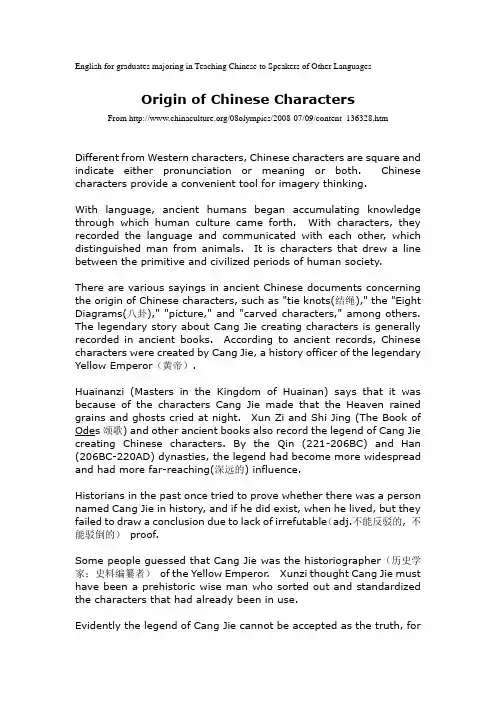
English for graduates majoring in Teaching Chinese to Speakers of Other LanguagesOrigin of Chinese CharactersFrom /08olympics/2008-07/09/content_136328.htm Different from Western characters, Chinese characters are square and indicate either pronunciation or meaning or both. Chinese characters provide a convenient tool for imagery thinking.With language, ancient humans began accumulating knowledge through which human culture came forth. With characters, they recorded the language and communicated with each other, which distinguished man from animals. It is characters that drew a line between the primitive and civilized periods of human society.There are various sayings in ancient Chinese documents concerning the origin of Chinese characters, such as "tie knots(结绳)," the "Eight Diagrams(八卦)," "picture," and "carved characters," among others. The legendary story about Cang Jie creating characters is generally recorded in ancient books. According to ancient records, Chinese characters were created by Cang Jie, a history officer of the legendary Yellow Emperor(黄帝).Huainanzi (Masters in the Kingdom of Huainan) says that it was because of the characters Cang Jie made that the Heaven rained grains and ghosts cried at night. Xun Zi and Shi Jing (The Book of Odes颂歌) and other ancient books also record the legend of Cang Jie creating Chinese characters. By the Qin (221-206BC) and Han (206BC-220AD) dynasties, the legend had become more widespread and had more far-reaching(深远的) influence.Historians in the past once tried to prove whether there was a person named Cang Jie in history, and if he did exist, when he lived, but they failed to draw a conclusion due to lack of irrefutable(adj.不能反驳的, 不能驳倒的)proof.Some people guessed that Cang Jie was the historiographer(历史学家;史料编纂者)of the Yellow Emperor. Xunzi thought Cang Jie must have been a prehistoric wise man who sorted out and standardized the characters that had already been in use.Evidently the legend of Cang Jie cannot be accepted as the truth, forany script can only be a creation developed by people to meet the needs of social life over a long period of trial and experiment. Chinese characters are a huge and complicated system, and they could only have come into being after a long period of creation and development.According to modern researchers, the ancestors of the Chinese people tied knots in rope to record events. Later, they adopted sharp weapons to inscribe(雕、刻)signs, and developed the earliest form of Chinese characters. Archeologists(考古学家)have found inscribed signs on Neolithic(['niə'lɪθɪk]新石器时代的)pottery(陶器)shards(碎片)in Banpo Village in Shaanxi Province. These signs, dating back to some 6,000 years ago, were possibly the seeds of later Chinese characters.Inscribed signs, a little younger than those found in Banpo Village, were also found on pottery along the lower reaches of the Yellow River (黄河下游). There, archeologists found a sign with shapes of the moon and a five-peak mountain underneath a circle. Experts in ancient characters say the pictograph(['pɪktəgrɑːf] n.象形文字, 古代石壁画)symbolizes the interval(距离,间隔)in which the moon disappears and the sun rises. Mythology([mɪ'θɒlədʒɪ]神话学)researchers have another interpretation. Their understanding is that the moon shape symbolizes the red clouds as the sun rises, and thus the picture portrays([pɔː'treɪ]描绘)a sunrise over the sea.Most of the signs inscribed on pottery were painted red, creating an imposing(adj.使人难忘的, 壮丽的)and mysterious impression. The hypothesis is that pictographs were used in sacrificial rituals(['rɪtʃʊəl]宗教仪式)dedicated to(献给)the sunrise or as prayers for good harvests. They were inscribed in an orderly way, and the strokes(笔画)are full of strength. Similar signs and designs have been found in other regions in China, indicating they had become generally recognized. These are the earliest symbols, or pictographs, in China and are more than 5,000 years old.In Qinghai Province in western China, pottery objects of approximately the same period and inscribed with images of birds, insects and animals have been unearthed(掘出). These, too, are regarded as pictographs. According to philologist(文献学者;语言学者)Tang Lan(唐兰), Chinese characters originated from pictures; The older the characters, the more they look like pictures. Since pictures have no fixed forms, the ancient Chinese characters were generally free in form.Xu Shen, a philologist of the Han Dynasty (206BC-220AD), divided Chinese characters into six categories. Modern scholars have since reduced them to three types, of which the pictographic character is one. The picture signs are the embryos(['embrɪəʊ]胚胎)of both calligraphy and painting, which gave rise to the Chinese saying that calligraphy and painting have the same origin. At first, the pictographic characters differed from region to region. As time went by, however, they become more standardized, abstract and united, and the earliest Chinese written language, Jiaguwen (shell and bone writing) appeared.Very important website: /index.htmNote: omniglot=omni+glot;omni=(Greek) all;glot=(Greek) language (see English glossary);omniglot=all languages.Origins of writing in ChinaFrom /writing/chinese.htmMost linguists believe that writing was invented in China during the latter half of the 2nd millennium BC and that there is no evidence to suggest the transmission of writing from elsewhere. The earliest recognizable examples of written Chinese date from 1500-950 BC (Shang dynasty) and were inscribed on ox scapulae and turtle shells - "oracle bones".In 1899 a scholar from Beijing named Wang Yirong noticed symbols that looked like writing on some "dragon bones" which he had been prescribed by a pharmacy. At that time "dragon bones" were often used in Chinese medicine and were usually animal fossils. Many more "oracle bones" were found in the ruins of the Shang capital near Anyang in the north of Henan province.The script on these "oracle bones" is known as 甲骨文(jiăgŭwén) - literally "shell bone writing". They were used for divination, a process which involved heating them then inspecting the resulting cracks to determine to answers to one's questions. The bones were then inscribed with details of the questions and the answers. Most of the questions involved hunting, warfare, the weather and the selection of auspicious days for ceremonies.A collection of oracle bones in the National Palace Museum near Taipei.Recently archaeologists in China have unearthed many fragments of neolithic pottery, the oldest of which date from about 4800 BC, inscribed with symbols which could be a form of writing. None of these symbols resemble any of the Shang characters and the likelyhood of deciphering them is remote given the paucity of material.The Chinese writing systemChinese is written with characters which are known as 漢字[汉字] (hànzi). The characters were originally pictures of people, animals or other things, but over the centuries they have become increasingly stylized and no longer resemble the things they represent. Many characters have been combined with others to create new ones.Until the early 20th century, Classical Chinese, 文言(wényán), was the main form of writing in China. It was standardized during the late Han Dynasty (25-220 AD) and was also used in Korea, Japan and Vietnam before they developed their own writing systems.In Classical Chinese most words were monosyllabic and written with a single character. However, during the 1920s a new form of written Chinese modelled on spoken Mandarin was developed. Most Chinese publications since then have been written in this form, which is known as 白話[白话] (báihuà), though Classical Chinese constructions and especially proverbs are still used to some extent.In spoken Chinese, words are made up of one, two or more syllables. Each of the syllables is written with a separate character. Each character has its own meaning, though many are used only in combination with other characters.Every character is given exactly the same amount of space, no matter how complex it is. There are no spaces between characters and the characters which make up multi-syllable words are not grouped together, so when reading Chinese, you not only have to work out what the characters mean and how to pronounce them, but also which characters belong together.How many characters?The Chinese writing system is an open-ended one, meaning that there is no upper limit to the number of characters. The largest Chinese dictionaries include about 56,000 characters, but most of them are archaic, obscure or rare variant forms. Knowledge of about 3,000 characters enables you to read about 99% of the characters used in Chinese newspapers and magazines. To read Chinese literature, technical writings or Classical Chinese though, you need to be familiar with at least 6,000 characters.UsageCharacters can be used on their own, in combination with other characters or as part of other characters.StrokesFrom /writing/chinese.htmChinese characters are written with the following twelve basic strokes:A character may consist of between 1 and 64 stokes. The strokes are always written in the same direction and there is a set(固定的)order to write the strokes of each character. In dictionaries, characters are ordered partly by the number of stokes they contain.NotesThe 39-stroke character (3 x thunder) means "the sound of thunder" and is always written doubled (靐靐). The 48-stroke character (3 dragons) means "the appearance of a dragon walking".HomophonesThere are approximately 1,700 possible syllables in Mandarin, which compares with over 8,000 in English. As a result, there are many homophones - syllables which sound the same but mean different things. These are distinguished in written Chinese by using different characters for each one.Not all the following characters are pronounced with the same tone, so to Chinese ears they sound different. To Western ears however they all sound the same. These syllables can be distinguished in speech from the context and because most of them usually appear in combination with other syllables.If you look closely, you will notice that some of the characters above have parts in common. These parts give you a clue to how to pronounce the characters.More examples of homophonesIt is even possible to write a text in Chinese using on one sound, pronounced with different tones, of course. This is exactly what Chinese linguist, Zhao Yuanren, did when he wrote the "Story of Shi Eating the Lions" using nothing but the sound 'shi'. The story makes sense in written form, but is impossible to understand when read aloud.You can see and hear the story on:/onlinelit/stonelion.html施氏食獅史shi1 shi4 shi2 shi1 shi3Story of Shi Eating the Lions石室詩士施氏, shi2 shi4 shi1 shi4 shi1shi4,A poet named Shi lived in a stone room,嗜獅,誓食十獅. shi4 shi1, shi4 shi2 shi2shi1.fond of lions, he swore that he would eat tenlions.氏時時適市視獅. shi4 shi2 shi2 shi4 shi4shi4 shi1.He constantly went to the market to look forten lions.十時,適十獅適市. shi2 shi2, shi4 shi2 shi1shi4 shi4.At ten o'clock, ten lions came to the market是時,適施氏適是市. shi4 shi2, shi4 shi1 shi4shi4 shi4 shi4.and Shi went to the market.氏視是十獅,恃矢勢, shi4 shi4 shi4 shi2 shi1,shi4 shi3 shi4,Looking at the ten lions, he relied on hisarrows使是十獅逝世. shi3 shi4 shi2 shi1 shi4shi4.to cause the ten lions to pass away.氏拾是十獅屍, 適石室. shi4 shi2 shi4 shi2 shi1shi1, shi4 shi2 shi4.Shi picked up the corpses of the ten lions andtook them to his stone room.石室濕,氏使侍拭石室. shi2 shi4, shi1, shi4 shi3shi4 shi4 shi2 shi4.The stone room was damp. Shi ordered aservant to wipe the stone room.石室拭,氏始試食十獅屍. shi2 shi4 shi4, shi4 shi3shi4 shi2 shi2 shi1 shi1.As the stone den was being wiped, Shi beganto try to eat the meat of the ten lions.食時, 始識十獅屍, shi2 shi2, shi3 shi4 shi4shi2 shi1 shi1,At the time of the meal, he began to realizethat the ten lion corpses實十石獅屍. shi2 shi2 shi2 shi1 shi1. were in fact were ten stone lions.試釋是事. shi4 shi4 shi4 shi4 Try to explain this matter.Compound wordsChinese verbs and adjectives generally consist of one character (syllable) but nouns often consist of two, three or more characters (syllables):Simplified Chinese charactersThe Simplified script (a.k.a.<also known as又名> Simplified Chinese) was officially adopted in the People's Republic of China in 1949 in an effort to eradicate(根除)illiteracy. The simplified script is also used in Singapore but the older traditional characters are still used in Taiwan, Hong Kong, Macau and Malaysia.A second round of simplifications which was published in 1977 but proved very unpopular and was abandoned in 1986.About 2,000 characters have been simplified in a number of different ways (the simplified characters are shown in red):Many simplified characters are based on commonly used abbreviations:Others retain only one part from the traditional character.Some replace the phonetic element of the traditional character with a simpler one that is pronounced in the same or in a similar way:In some cases, several traditional characters are represented by one simplified character:Recently the traditional characters have started to make a come back, particularly in southern China.Sample text in ChineseHànyŭ pīnyīn transliterationRénrén shēng ér zìyóu, zài zūnyán hé quánlì shàng yīlǜpíngdĕng. Tāmen fùyŏu lĭxìng hé liángxīn, bìng yīng yĭ xiōngdì guānxì de jīngshén hùxiāng duìdài.Direction of writingTraditionally Chinese was written from right to left in vertical columns. The first publication in Chinese using horizontal (left to right) text was Robert Morrison's Dictionary of the Chinese language, published in 1815–1823 in Macau. The increasing use of words in Western languages, especially English, in Chinese texts from the early 20th century made horizontal texts more popular.Since 1949 horizontal writing has become the standard in the PRC, and all PRC newspapers changed from vertical to horizontal text in 1956, though some headlines are written vertically, as are inscriptions(题字)of signs on most state organizations.The horizontal writing of Chinese is normal in Singapore, and it has been gradually adopted in Hong Kong, Macao and in overseas Chinese communities since the 1990s.Vertical text remains popular in Taiwan however, though horizontal text is used as well. In Taiwan newspapers and magazines with vertical text, some of the headlines and titles are written horizontally right to left across the top of the main text.Use of Chinese characters for other languagesChinese characters are used to write Modern Standard Chinese, which is based largely on spoken Mandarin. Other varieties of Chinese, especially Cantonese, are sometimes written with Chinese characters, or with a combination of characters and words in the Latin alphabet. Some of the characters used are archaic(陈旧的,古老的)or invented specifically for these languages.Chinese characters have been used to write Japanese and Korean and Vietnamese. They are still used in written Japanese, in combination with hiragana(平假名-日文字母的草体)and katakana(片假名), and to a much lesser in written Korean, while Vietnamese is now written with the Latin alphabet.Evolution of Chinese CharactersFrom /writing/chinese_evolution.htmThe images(图象)below illustrate how a number of Chinese characters have changed over time from their earliest known pictographic(象形文字的)forms, to the versions used today.The Large Seal and Small Seal scripts are still used to write names on personal name chops(官印), and are also occasionally used to write company names on buildings, stationery(文具), name cards, etc.The Grass script (a.k.a. <also known as又名> Cursive script) is used mainly for Chinese calligraphy. Each character is written with one continuous stroke, which enables very rapid writing, though characters written in this way are difficult to read. Legibility(易辨性)is not a primary concern for Chinese calligraphers, instead they aim to produce calligraphy that is aesthetically(审美地)pleasing.The Simplified script(a.k.a. Simplified Chinese), was officially adopted in the People's Republic of China in 1949 in an effort to eradicate illiteracy. It is also used in Singapore.Sample textsSmall Seal Script (小篆)Clerical Script (隸書)Standard Script with zhùyīn fúhào (楷書)Running script (行書)Grass scriptSimplified characters (简体字)。
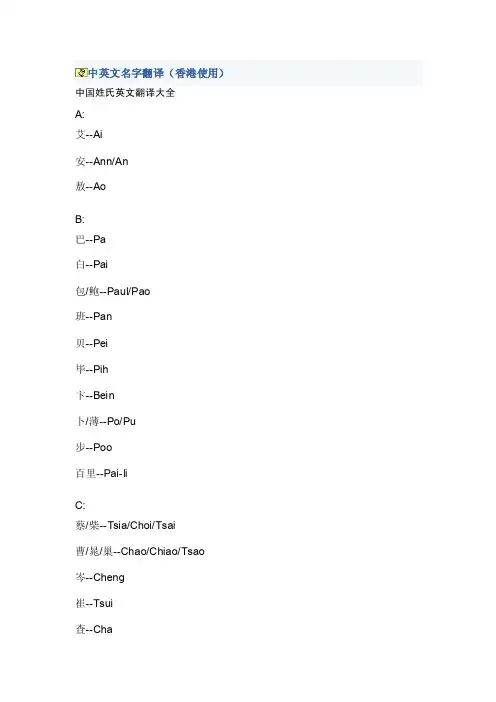
中英文名字翻译(香港使用)中国姓氏英文翻译大全A:艾--Ai安--Ann/An敖--AoB:巴--Pa白--Pai包/鲍--Paul/Pao班--Pan贝--Pei毕--Pih卞--Bein卜/薄--Po/Pu步--Poo百里--Pai-liC:蔡/柴--Tsia/Choi/Tsai曹/晁/巢--Chao/Chiao/Tsao岑--Cheng崔--Tsui查--Cha常--Chiong车--Che陈--Chen/Chan/Tan 成/程--Cheng池--Chi褚/楚--Chu淳于--Chwen-yuD:戴/代--Day/Tai邓--Teng/Tang/Tung狄--Ti刁--Tiao丁--Ting/T董/东--Tung/Tong窦--Tou杜--To/Du/Too段--Tuan端木--Duan-mu东郭--Tung-kuo东方--Tung-fang E:F:范/樊--Fan/Van房/方--Fang费--Fei冯/凤/封--Fung/Fong 符/傅--Fu/FooG:盖--Kai甘--Kan高/郜--Gao/Kao葛--Keh耿--Keng弓/宫/龚/恭--Kung勾--Kou古/谷/顾--Ku/Koo桂--Kwei管/关--Kuan/Kwan 郭/国--Kwok/Kuo公孙--Kung-sun公羊--Kung-yang公冶--Kung-yeh谷梁--Ku-liangH:韩--Hon/Han杭--Hang郝--Hoa/Howe何/贺--Ho桓--Won侯--Hou洪--Hung胡/扈--Hu/Hoo花/华--Hua宦--Huan黄--Wong/Hwang霍--Huo皇甫--Hwang-fu呼延--Hu-yenI:J:纪/翼/季/吉/嵇/汲/籍/姬--Chi 居--Chu贾--Chia翦/简--Jen/Jane/Chieh蒋/姜/江/--Chiang/Kwong金/靳--Jin/King景/荆--King/Ching讦--GanK:阚--Kan康--Kang柯--Kor/Ko孔--Kong/Kung寇--Ker蒯--Kuai匡--KuangL:赖--Lai蓝--Lan郎--Long劳--Lao乐--Loh雷--Rae/Ray/Lei冷--Leng黎/郦/利/李--Lee/Li/Lai/Li 连--Lien梁--Leung/Liang林/蔺--Lim/Lin凌--Lin柳/刘--Liu/Lau龙--Long楼/娄--Lou卢/路/陆鲁--Lu/Loo伦--Lun罗/骆--Loh/Lo/Law/Lam/Rowe 吕--Lui/Lu令狐--Lin-hooM:马/麻--Ma麦--Mai/Mak满--Man/Mai毛--Mao梅--Mei孟/蒙--Mong/Meng米/宓--Mi苗/缪--Miau/Miao闵--Min穆/慕--Moo/Mo 莫--Mok/Mo万俟--Moh-chi慕容--Mo-yungN:倪--Nee甯--Ning聂--Nieh牛--New/Niu农--Long南宫--Nan-kung欧/区--Au/Ou欧阳--Ou-yangP:潘--Pang/Pan庞--Pang裴--Pei/Bae彭--Phang/Pong 皮--Pee平--Ping浦/蒲/卜--Poo/Pu濮阳--Poo-yangQ:祁/戚/齐--Chi/Chyi/Chi/Chih 钱--Chien乔--Chiao/Joe秦--Ching裘/仇/邱--Chiu屈/曲/瞿--Chiu/ChuR:冉--Yien饶--Yau任--Jen/Yum容/荣--Yung阮--Yuen芮--NeiS:司--Sze桑--Sang沙--Sa邵--Shao单/山--San尚/商--Sang/Shang沈/申--Shen盛--Shen史/施/师/石--Shih/Shi苏/宿/舒--Sue/Se/Soo/Hsu 孙--Sun/Suen宋--Song/Soung司空--Sze-kung司马--Sze-ma司徒--Sze-to单于--San-yu上官--Sang-kuan申屠--Shen-tuT:谈--Tan汤/唐--Town/Towne/Tang 邰--Tai谭--Tan/Tam陶--Tao藤--Teng田--Tien童--Tung屠--Tu澹台--Tan-tai拓拔--Toh-bahU:V:W:万--Wan王/汪--Wong魏/卫/韦--Wei温/文/闻--Wen/Chin/Vane/Man 翁--Ong吴/伍/巫/武/邬/乌--Wu/NG/Woo X:奚/席--Hsi/Chi夏--Har/Hsia/(Summer)肖/萧--Shaw/Siu/Hsiao项/向--Hsiang解/谢--Tse/Shieh辛--Hsing刑--Hsing熊--Hsiung/Hsiun许/徐/荀--Shun/Hui/Hsu宣--Hsuan薛--Hsueh西门--See-men夏侯--Hsia-hou轩辕--Hsuan-yuenY:燕/晏/阎/严/颜--Yim/Yen杨/羊/养--Young/Yang姚--Yao/Yau叶--Yip/Yeh/Yih伊/易/羿--Yih/E殷/阴/尹--Yi/Yin/Ying应--Ying尤/游--Yu/You俞/庾/于/余/虞/郁/余/禹--Yue/Yu袁/元--Yuan/Yuen岳--Yue云--Wing尉迟--Yu-chi宇文--Yu-wenZ:藏--Chang曾/郑--Tsang/Cheng/Tseng訾--Zi宗--Chung左/卓--Cho/Tso翟--Chia詹--Chan甄--Chen湛--Tsan张/章--Cheung/Chang赵/肇/招--Chao/Chiu/Chiao/Chioa周/邹--Chau/Chou/Chow钟--Chung祖/竺/朱/诸/祝--Chu/Chuh庄--Chong钟离--Chung-li诸葛--Chu-keh以下不是英语,广东人也不用这种拼音!是香港拼音!香港拼音- 汉字对照表AH 亚AH 雅AU 区AU 欧BIK 碧BIK 璧BING 丙BING 冰BING 秉BING 炳BIT 必BONG 邦BUN 斌CHAI 仔CHAI 齐CHAI 齐CHAK 翟CHAK 泽CHAM 湛CHAN 陈CHAN 灿CHAN 璨CHAN 镇CHAN 赞CHAN 瓒CHANG 郑CHAT 七CHAU 舟CHAU 周CHAU 洲CHAU 秋CHAU 邹CHEN 陈CHENG 郑CHEONG 张CHEONG 章CHEUK 灼CHEUK 卓CHEUK 卓CHEUK 棹CHEUK 绰CHEUK 焯CHEUNG 昌CHEUNG 长CHEUNG 张CHEUNG 祥CHEUNG 掌CHEUNG 翔CHEUNG 象CHEUNG 璋CHEUNG 蒋CHEUNG 锵CHI 子CHI 之CHI 次CHI 池CHI 志CHI 枝CHI 知CHI 芝CHI 芷CHI 姿CHI 祉CHI 致CHI 戚CHI 梓CHI 智CHI 紫CHI 慈CHI 志CHI 赐CHI 炽CHIANG 张CHICK 戚CHIGN 净CHIK 戚CHIK 绩CHIK 积CHIN 前CHIN 展CHIN 钱CHIN 钱CHIN 芊CHING 正CHING 呈CHING 青CHING 政CHING 贞CHING 情CHING 清CHING 晴CHING 晶CHING 程CHING 程CHING 菁CHING 靖CHING 精CHING 澄CHING 静CHIT 哲CHIU 肖CHIU 招CHIU 俏CHIU 昭CHIU 钊CHIU 钏CHIU 朝CHIU 超CHIU 照CHIU 赵CHIU 潮CHIU 霄CHO 祖CHO 曹CHO 袓CHOI 才CHOI 再CHOI 材CHOI 采CHOI 财CHOI 彩CHOI 载CHOI 蔡CHOI 赛CHOK 作CHONG 壮CHONG 庄CHONG 庄CHONG 创CHOR 佐CHOR 初CHOR 楚CHOR 础CHOW 周CHOW 邹CHOY 蔡CHU 朱CHU 柱CHU 珠CHU 曙CHU 焌CHUEN 川CHUEN 中CHUEN 全CHUEN 春CHUEN 泉CHUEN 传CHUEN 铨CHUI 徐CHUI 崔CHUI 隋CHUI 翠CHUI 趣CHUM 覃CHUN 俊CHUN 津CHUN 珍CHUN 振CHUN 晋CHUN 浚CHUN 真CHUN 秦CHUN 竣CHUN 进CHUN 隽CHUN 榛CHUN 臻CHUN 骏CHUN 椿CHUN 蓁CHUNG 仲CHUNG 冲CHUNG 宗CHUNG 忠CHUNG 松CHUNG 重CHUNG 从CHUNG 颂CHUNG 诵CHUNG 聪CHUNG 锺CHUNG 锺CHUNG 琮CHUNG 璁DIK 迪DIK 荻DIU 吊FAT 发FA 花FAI 晖FAI 辉FAN 帆FAN 芬FAN 范FAN 勋FAN 熏FANG 方FAT 佛FEI 飞FEI 菲FO 科FOG 霍FOK 霍FONG 方FONG 芳FOO 火FOO 伙FOO 符FOOK 服FOOK 福FOON 宽FOON 欢FORK 霍FU 芙FU 符FU 傅FU 富FUI 奎FUK 褔FUNG 丰FUNG 风FUNG 峰FUNG 烽FUNG 逢FUNG 冯FUNG 冯FUNG 枫FUNG 凤FUNG 锋FUNG 丰HING 兴HA 夏HA 夏HA 霞HAN 闲HAN 娴HANG 行HANG 亨HANG 杏HANG 幸HANG 幸HANG 恒HANG 衡HANG 铿HANG 姮HANG 珩HANG 蘅HANG 恒HAU 口HAU 巧HAU 孝HAU 侯HAU 厚HAU 校HEI 希HEI 晞HEI 喜HEI 器HEI 熹HEI 羲HEI 禧HEI 曦HEI 浠HEUNG 向HEUNG 香HEUNG 香HIM 谦HIN 衍HIN 轩HIN 宪HIN 献HIN 骞HIN 显HING 卿HING 庆HING 罄HING 馨HIP 协HIU 晓HO 可HO 好HO 何HO 河HO 浩HO 荷HO 皓HO 贺HO 豪HO 濠HO 颢HO 灏HOI 海HOI 凯HOI 开HOI 爱HOI 恺HOI 垲HOI 铠HOK 学HOK 鹤HON 侃HON 汉HON 翰HON 韩HON 瀚HONG 匡HONG 航HONG 康HONG 康HOU 侯HSU 许HSUI 许HUANG 黄HUEN 萱HUEN 禤HUI 许HUI 昫HUNG 孔HUNG 孔HUNG 洪HUNG 洪HUNG 红HUNG 虹HUNG 雄HUNG 熊HUNG 熊HUNG 鸿HWANG 黄I 漪IP 叶JIM 詹KA 加KA 圻KA 家KA 嘉KA 珈KAI 佳KAI 契KAI 桂KAI 启KAI 楷KAI 继KAI 棨KAK 革KAK 极KAM 甘KAM 甘KAM 金KAM 金KAM 淦KAM 琴KAM 锦KAM 鑫KAN 芹KAN 根KAN 勤KAN 简KAN 谨KANG 更KANG 镜KAR 贾KAU 九KAU 球KEI 其KEI 奇KEI 祈KEI 纪KEI 基KEI 淇KEI 期KEI 棋KEI 琪KEI 琦KEI 祺KEI 旗KEI 玑KEI 锜KEI 麒KEI 娸KEI 颀KEUNG 姜KEUNG 强KHOO 古KIM 俭KIM 剑KIN 建KIN 健KIN 坚KIN 键KING 劲KING 景KING 敬KING 璟KING 琼KING 竞KIT 杰KIT 杰KIT 结KIT 洁KIU 乔KIU 娇KIU 桥KIU 翘KIU 荞KO 高KO 高KOK 铬KON 干KONG 江KONG 江KONG 刚KONG 港KOO 古KOON 冠KOON 观KOT 葛KU 古KUA 瓜KUEN 娟KUEN 权KUI 巨KUI 居KUI 渠KUI 驹KUI 举KUI 琚KUK 公KUK 局KUK 谷KUK 菊KUN 贯KUNG 功KUNG 恭KUNG 恭KUNG 龚KUO 古KWAI 贵KWAI 贵KWAI 湀KWAN 君KWAN 均KWAN 坤KWAN 昆KWAN 昆KWAN 焜KWAN 钧KWAN 筠KWAN 群KWAN 关KWAN 关KWING 炯KWOK 国KWOK 郭KWOK 郭KWONG 光KWONG 广KWONG 邝LAI 黎LAI 赖LAI 励LAI 礼LAI 丽LAI 豊LAI 鹂LAM 林LAM 林LAM 淋LAM 琳LAM 霖LAM 临LAM 蓝LAN 兰LAP 立LARM 蓝LAU 柳LAU 流LAU 刘LAU 鎏LAW 罗LEE 李LEI 利LEI 理LEI 莉LEI 奶LEONG 梁LEUNG 良LEUNG 亮LEUNG 梁LEUNG 梁LI 利LI 李LIANG 梁LIAO 廖LIEW 廖LIK 力LIK 历LIM 林LIM 廉LIM 濂LIN 连LIN 连LIN 莲LING 令LING 泠LING 玲LING 苓LING 凌LING 凌LING 羚LING 翎LING 聆LING 钤LING 铃LING 领LING 龄LING 灵LIP 聂LIT 烈LIU 廖LO 劳LO 鲁LO 卢LOI 来LOK 恪LOK 洛LOK 乐LOK 诺LOK 骆LONG 朗LONG 塱LOO 卢LOOK 陆LOONG 龙LOW 卢LUEN 联LUEN 銮LUEN 鸾LUET 律LUI 吕LUI 雷LUI 雷LUI 蕾LUK 六LUK 陆LUK 陆LUK 禄LUM 林LUN 伦LUN 伦LUN 仑LUN 纶LUN 麟LUNG 隆LUNG 浓LUNG 龙LUNG 龙MA 马MA 马MAK 麦MAN 文MAN 文MAN 民MAN 汶MAN 曼MAN 问MAN 敏MAN 雯MAN 万MAN 旻MANG 孟MANG 萌MAO 茂MAR 马MEI 眉MEI 美MEI 媚MEI 微MEI 薇MEI 镁MIN 冕MING 名MING 明MING 明MING 铭MING 鸣MIU 妙MIU 苗MIU 苗MO 毛MO 巫MO 武MO 武MO 舞MO 慕MOK 莫MOOK 木MOON 满MUI 妹MUI 梅MUI 梅MUK 牧MUNG 梦NAM 男NAM 南NAM 岚NAM 楠NANG 能NAR 娜NEI 妮NEUNG 娘NG 五NG 伍NG 伍NG 吴NG 梧NGA 雅NGAI 艾NGAI 倪NGAI 毅NGAI 霓NGAI 魏NGAI 艺NGAN 晏NGAN 雁NGAN 韧NGAN 银NGAN 颜NGAN 颜NGAU 牛NGO 娥NGO 敖NGO 傲NGON 岸NIE 乃NIN 年NING 宁NING 柠NUI 女O 敖OI 蔼ON 安ON 铵OR 柯PAK 北PAK 白PAK 百PAK 伯PAK 柏PAK 珀PANG 彭PANG 彭PANG 鹏PAT 毕PAU 包PEI 丕PIK 碧PIK 璧PIN 卞PING 平PING 屏PING 炳PING 萍PING 骋PING 苹PIU 标PO 布PO 步PO 波PO 保PO 宝POK 博POK 璞PONG 庞POO 布POON 本POON 潘POON 潘PUI 沛PUI 佩PUI 佩PUI 培PUI 裴PUI 钡PUN 彬PUN 潘PUN 嫔PUN 滨SAI 世SAI 西SAI 细SAI 茜SAM 三SAM 森SAN 山SANG 生SAU 秀SAU 修SE 畲SECK 石SEE 施SEI 四SEK 石SHAN 珊SHE 畲SHEK 石SHEK 石SHEK 硕SHEUNG 尚SHEUNG 湘SHEUNG 嫦SHEUNG 裳SHEUNG 双SHI 仕SHIH 施SHING 成SHING 成SHING 城SHING 盛SHING 胜SHING 诚SHING 铖SHIU 萧SHP 十SHU 书SHU 舒SHU 树SHUE 舒SHUEN 孙SHUK 淑SHUM 岑SHUM 沈SHUN 信SHUN 纯SHUN 淳SHUN 舜SHUN 顺SHUN 逊SI 士SI 史SI 自SI 施SI 师SI 时SIK式SIK 锡SIM 婵SIN 仙SIN 倩SIN 单SIN 善SIN 羡SIN 冼SIN 仙SIN 蒨SING 升SING 成SING 承SING 升SING 星SING 升SING 圣SING 声SIT 薛SIU 小SIU 少SIU 兆SIU 邵SIU 笑SIU 绍SIU 诏SIU 肇SIU 韶SIU 啸SIU 萧SIU 劭SO 素SO 苏SO 苏SUEN 孙SUEN 楦SUEN 璇SUET 雪SUI 水SUI 萃SUI 瑞SUI 穗SUM 心SUM 沈SUM 芯SUM 深SUM 琛SUN 申SUN 辛SUN 新SUN 燊SUNG 宋SUNG 宋SUNG 崇SZE 司SZE 思SZE 施SZE 施SZE 斯SZE 丝SZE 诗SZE 锶TAI 大TAI 弟TAI 邸TAI 娣TAI 泰TAI 带TAI 棣TAI 戴TAK 特TAK 得TAK 德TAM 谈TAM 谭TAM 谭TAN 丹TAN 陈TANG 邓TAO 杜TAT 达TAU 土TAU 窦TIM 添TIM 甜TIN 天TIN 田TIN 田TIN 钿TING 丁TING 丁TING 廷TING 定TING 延TING 亭TING 庭TING 婷TING 鼎TING 霆TING 渟TIP 迭TIT 铁TO 杜TO 徒TO 桃TO 淘TO 都TO 滔TO 道TO 图TO 涛TO 韬TONG 唐TONG 棠TONG 汤TSAM 沁TSANG 曾TSANG 增TSE 谢TSIM 詹TSO 灶TSO 曹TSOI 蔡TSUI 徐TSUI 崔TUEN 段TUEN 端TUNG 冬TUNG 同TUNG 彤TUNG 东TUNG 桐TUNG 通TUNG 栋TUNG 童TUNG 筒TUNG 董TUNG 董TUNG 腾TYE 戴UNG 莺VONG 黄WAH 华WAH 桦WAH 烨WAH 骅WAI 位WAI 威WAI 为WAI 韦WAI 韦WAI 伟WAI 尉WAI 帏WAI 惠WAI 渭WAI 苇WAI 维WAI 慧WAI 慰WAI 纬WAI 蔚WAI 卫WAI 蕙WAI 怀WAI 炜WAI 玮WAI 鏸WAN 尹WAN 尹WAN 允WAN 芸WAN 云WAN 温WAN 运WAN 环WAN 韵WAN 蕴WAN 薀WANG 王WANG 宏WANG 泓WANG 纮WAT 屈WING 永WING 泳WING 咏WING 荣WING 荣WING 颖WO 和WO 胡WON 旺WONG 王WONG 汪WONG 黄WONG 黄WONG 黄WONG 煌WOO 胡WOOD 活WOON 垣WOON 奂WOON 媛WOON 焕WOON 缓WU 胡WU 湖WU 护WUI 会WUN 桓WUT 屈YAM 任YAM 钦YAM 荫YAN 人YAN 仁YAN 因YAN 昕YAN 欣YAN 胤YAN 恩YAN 殷YAN 殷YAN 茵YAN 寅YAN 殷YAN 甄YAN 忻YANG 杨YAO 邱YAT 日YAT 逸YAT 溢YAU 友YAU 尤YAU 有YAU 佑YAU 攸YAU 邱YAU 幽YAU 柔YAU 佑YAU 游YAU 优YAU 筱YEE 一YEE 二YEE 以YEE 伊YEE 圯YEE 儿YEE 宜YEE 怡YEE 治YEE 倚YEE 椅YEE 贻YEE 意YEE 义YEE 绮YEE 仪YEE 谊YEE 颐YEE 懿YEE 苡YEI 熙YEN 殷YEUK 约YEUK 若YEUNG 洋YEUNG 扬YEUNG 阳YEUNG 阳YEUNG 杨YEUNG 杨YI 依YI 尔YICK 易YIK 亦YIK 易YIK 易YIK 奕YIK 益YIK 亿YIK 翼YIM 严YIM 艳YIN 卉YIN 妍YIN 言YIN 彦YIN 然YIN 贤YIN 燕YIN 燃YING 邢YING 映YING 盈YING 英YING 瑛YING 影YING 莹YING 凝YING 应YING 樱YING 蛮YING 礽YING 滢YING 潆YIP 业YIP 叶YIP 叶YIU 姚YIU 姚YIU 尧YIU 瑶YIU 娆YIU 曜YIU 耀YIU 饶YOUNG 杨YU 予YU 如YU 宇YU 汝YU 羽YU 余YU 雨YU 俞YU 昱YU 峪YU 茹YU 庾YU 御YU 愉YU 渝YU 榆YU 瑜YU 虞YU 裕YU 余YU 儒YUE 俞YUEN 元YUEN 沅YUEN 阮YUEN 宛YUEN 袁YUEN 婉YUEN 渊YUEN 园YUEN 源YUEN 远YUEN 润YUEN 浣YUEN 琬YUEN 菀YUET 乙YUET 月YUET 玥YUET 悦YUET 越YUET 粤YUET 钺YUI 裔YUI 锐YUI 蕊YUI 睿YUK 玉YUK 旭YUK 育YUK 毓YUK 煜YUK 淯YUK 钰YUNG 用YUNG 勇YUNG 容YUNG 翁YUNG 雍YUNG 榕YUNG 蓉YUNG 融YUNG 晹ZHANG 张。
《尚书》汉英对照_周秉钧今译-大中华文库_外文对照版-回复尚书(又称《尚书大传》)是中国古代文献中的一部重要著作,是我国最早的记载国家政治制度、历史事件和文化传承的百科全书。
它以书信和诏令的形式,记述了从周朝开始,历代君王与大臣之间的谈话、商议和指示,具有很高的历史价值和文化意义。
在汉英对照版的《尚书》中,每一段汉字的翻译都有相应的英文对照。
这种汉英对照的形式可以帮助我们更好地理解《尚书》的内容和意义。
下面,我将逐步回答中括号内的问题,并对《尚书》的汉英对照版进行解读。
首先,我们需要了解《尚书》的来源和背景。
《尚书》是古代君主用来记载重要政务和传达命令的一种文书形式,它记录了周朝及其后继的历代王朝的治理经验和政治理念。
通过阅读《尚书》,我们可以了解到中国古代政治制度的起源与发展,以及古代王朝的治国之道。
从翻译的角度来看,汉英对照版的《尚书》能够帮助我们更好地理解古代汉字的含义和用法。
每个汉字的对照英文都可以帮助我们准确地理解作者的意图和描述。
同时,该版本还能够帮助英语读者更好地学习和了解中文,通过对照原文和翻译,英语读者可以扩大他们的中文词汇储备,并提高他们的语言表达能力。
接下来,让我们以汉英对照版《尚书》的内容为线索,一步一步进行解读和回答。
[《邦誓》]中,作者描述了古代君王和臣民之间的约定和守信原则,以及对于国家发展的美好愿景。
通过这段诏令,我们可以了解到古代中国君主对于政治道德和国家安宁的重视。
作者强调,君王应该具备高尚的品德和崇高的理想,并通过正确的行为来树立榜样,并要求臣民忠诚和守信。
这段诏令也提到了古代中国对于社会和谐的重视,君王希望人民能够和睦相处,并共同致力于祖国的繁荣昌盛。
[《汤杂谢》]是《尚书》中的一篇重要篇章,记录了周朝太祖武王代周兴起,推翻暴政的商朝的历史事件。
通过这篇文献,我们可以了解到古代文明的崛起与衰落,以及改朝换代的历史过程。
武王在这篇文献中向天下人民宣告商朝的罪行,并表明了他推翻商朝、建立周朝的决心。
中英⽂字体名对照表(包括⽅正、⽂⿍)在CSS⽂件中,我们常看到有些字体名称变成了乱码,这是由于编写者将中⽂字体的名字直接写成了中⽂,为了避免这种状况出现,在CSS⽂件中使⽤中⽂字体时,最好使⽤中⽂字体的英⽂名称,需要的朋友可以注意下新細明體PMingLiU細明體MingLiU標楷體DFKai-SB⿊体SimHei宋体SimSun新宋体NSimSun仿宋FangSong楷体KaiTi仿宋_GB2312FangSong_GB2312楷体_GB2312KaiTi_GB2312微軟正⿊體Microsoft JhengHei微软雅⿊体Microsoft YaHei⾪书LiSu幼圆YouYuan华⽂细⿊STXihei华⽂楷体STKaiti华⽂宋体STSong华⽂中宋STZhongsong华⽂仿宋STFangsong⽅正舒体FZShuTi⽅正姚体FZYaoti华⽂彩云STCaiyun华⽂琥珀STHupo华⽂⾪书STLiti华⽂⾏楷STXingkai华⽂新魏STXinwei⽅正字体简体部分中⽂字体名英⽂字体名⽂件名PSname 汉字数⽅正报宋简体FZBaoSong-Z04S FZBSJW FZBSJW-GB1-07156⽅正粗圆简体FZCuYuan-M03S FZY4JW FZY4JW-GB1-07156⽅正⼤标宋简体FZDaBiaoSong-B06S FZDBSJWFZDBSJW-GB1-7156⽅正⼤⿊简体FZDaHei-B02S FZDHTJW FZDHTJW-GB1-7156⽅正仿宋简体FZFangSong-Z02S FZFSJW FZFSJW-GB1-07156⽅正⿊体简体FZHei-B01S FZHTJW FZHTJW-GB1-07156⽅正琥珀简体FZHuPo-M04S FZHPJW FZHPJW-GB1-07156⽅正楷体简体FZKai-Z03S FZKTJW FZKTJW-GB1-07156⽅正⾪变简体FZLiBian-S02S FZLBJW FZLBJW-GB1-07156⽅正⾪书简体FZLiShu-S01S FZLSJW FZLSJW-GB1-07156⽅正美⿊简体FZMeiHei-M07S FZMHJW FZMHJW-GB1-07156⽅正书宋简体FZShuSong-Z01S FZSSJW FZSSJW-GB1-07156⽅正舒体简体FZShuTi-S05S FZSTJW FZSTJW-GB1-07152⽅正⽔柱简体FZShuiZhu-M08S FZSZJW FZSZJW-GB1-07156⽅正宋⿊简体FZSongHei-B07S FZSHJW FZSHJW-GB1-07156⽅正宋三简体FZSong III-Z05S FZS3JW FZS3JW-GB1-07156⽅正魏碑简体FZWeiBei-S03S FZWBJW FZWBJW-GB1-07156⽅正细等线简体FZXiDengXian-Z06S FZXDXJWFZXDXJW-GB1-7156⽅正细⿊⼀简体FZXiHei I-Z08S FZXH1JWFZXH1JW-GB1-7156⽅正细圆简体FZXiYuan-M01S FZY1JW FZY1JW-GB1-07156⽅正⼩标宋简体FZXiaoBiaoSong-B05SFZXBSJWFZXBSJW-GB1-7156⽅正⾏楷简体FZXingKai-S04S FZXKJW FZXKJW-GB1-07156⽅正姚体简体FZYaoTi-M06S FZYTJW FZYTJW-GB1-07156⽅正中等线简体FZZhongDengXian-Z07SFZZDXJWFZZDXJW-GB1-7156⽅正准圆简体FZZhunYuan-M02S FZY3JW FZY3JW-GB1-07156⽅正综艺简体FZZongYi-M05S FZZYJW FZZYJW-GB1-07156⽅正彩云简体FZCaiYun-M09S FZCYJW FZCYJW-GB1-07156⽅正⾪⼆简体FZLiShu II-S06S FZL2JW FZL2JW-GB1-07156⽅正康体简体FZKangTi-S07S FZKANGJW FZKANGJW-GB1-07156⽅正超粗⿊简体FZChaoCuHei-M10S FZCCHJWFZCCHJW-GB1-07156⽅正新报宋简体FZNew BaoSong-Z12SFZNBSJWFZNBSJW-GB1097156⽅正新舒体简体FZNew ShuTi-S08S FZNSTJWFZNSTJW-GB1-7156⽅正黄草简体FZHuangCao-S09S FZHCJW FZHCJW-GB1-06763⽅正少⼉简体FZShaoEr-M11S FZSEJW FZSEJW-GB1-07156⽅正稚艺简体FZZhiYi-M12S FZZHYJW FZZHYJW-GB1-7156⽅正细珊瑚简体FZXiShanHu-M13S FZXSHJWFZXSHJW-GB1-7156⽅正粗宋简体FZCuSong-B09S FZCSJW FZCSJW-GB1-07156⽅正平和简体FZPingHe-S11S FZPHTJW FZPHTJW-GB1-7156⽅正华⾪简体FZHuaLi-M14S FZHLJW FZHLJW-GB1-07156⽅正瘦⾦书简体FZShouJinShu-S10S FZSJSJWFZSJSJW-GB1-7156⽅正细倩简体FZXiQian-M15S FZXQJW FZXQJW-GB1-07156⽅正中倩简体FZZhongQian-M16S FZZQJW FZZQJW-GB1-07156⽅正粗倩简体FZCuQian-M17S FZCQJW FZCQJW-GB1-07156⽅正胖娃简体FZPangWa-M18S FZPWJW FZPWJW-GB1-07156⽅正宋⼀简体FZSongYi-Z13S FZSYJW FZSYJW-GB1-07156繁体部分中⽂字体名英⽂字体名⽂件名PSname 汉字数⽅正报宋繁体FZBaoSong-Z04T FZXLFW FZXLFW-GB1-06866⽅正彩云繁体FZCaiYun-M09T FZCYFW FZCYFW-GB1-06866⽅正超粗⿊繁体FZChaoCuHei-M10T FZCCHFWFZCCHFW-GB1-06866⽅正粗⿊繁体FZCuHei-B03T FZH4FW FZH4FW-GB1-06866⽅正粗圆繁体FZCuYuan-M03T FZY4FW FZY4FW-GB1-06866⽅正⼤标宋繁体FZDaBiaoSong-B06T FZDBSFWFZDBSFW-GB1-06866⽅正仿宋繁体FZFangSong-Z02T FZFSFW FZFSFW-GB1-06866⽅正⿊体繁体FZHei-B01T FZHTFW FZHTFW-GB1-06866⽅正琥珀繁体FZHuPo-M04T FZHPFW FZHPFW-GB1-06866⽅正楷体繁体FZKai-Z03T FZKTFW FZKTFW-GB1-06866⽅正⾪变繁体FZLiBian-S02T FZLBFW FZLBFW-GB1-06866⽅正平⿊繁体FZPingHei-B04T FZPHFW FZPHFW-GB1-06866⽅正书宋繁体FZShuSong-Z01T FZSSFW FZSSFW-GB1-06866⽅正舒体繁体FZShuTi-S05T FZSTFW FZSTFW-GB1-06866⽅正魏碑繁体FZWeiBei-S03T FZWBFW FZWBFW-GB1-6866⽅正细⿊⼀繁体FZXiHei I-Z08T FZXH1FWFZXH1FW-GB1-6866⽅正细圆繁体FZXiYuan-M01T FZY1FW FZY1FW-GB1-06866⽅正⼩标宋繁体FZXiaoBiaoSong-B05TFZXBSFWFZXBSFW-GB1-6866⽅正新书宋繁体FZNew ShuSong-Z10TFZXSSFWFZXSSFW-GB1-6866⽅正新秀丽繁体FZNew XiuLi-Z11T FZXXLFWFZXXLFW-GB1-6866⽅正⾏楷繁体FZXingKai-S04T FZXKFW FZXKFW-GB1-06866⽅正幼线繁体FZYouXian-Z09T FZYXFW FZYXFW-GB1-06866⽅正中楷繁体FZZhongKai-B08T FZZKFW FZZKFW-GB1-06866⽅正准圆繁体FZZhunYuan-M02T FZY3FW FZY3FW-GB1-06866⽅正综艺繁体FZZongYi-M05T FZZYFW FZZYFW-GB1-06866⽅正⾪⼆繁体FZLiShu II-S06T FZL2FW FZL2FW-GB1-06866⽅正新舒体繁体FZNew ShuTi-S08T FZNSTFWFZNSTFW-GB1-6866⽅正康体繁体FZKangTi-S07T FZKANGFW FZKANGFW-GB1-06866⽅正⽔柱繁体FZShuiZhu-M08T FZSZFW FZSZFW-GB1-06866⽅正姚体繁体FZYaoTi-M06T FZYTFW FZYTFW-GB1-06866⽅正瘦⾦书繁体FZShouJinShu-S10T FZSJSFWFZSJSFW-GB1-6866⽅正少⼉繁体FZShaoEr-M11T FZSEFW FZSEFW-GB1-06866⽅正稚艺繁体FZZhiYi-M12T FZZHYFW FZZHYFW-GB1-6866⽅正细珊瑚繁体FZXiShanHu-M13T FZXSHFWFZXSHFW-GB1-06866⽅正粗宋繁体FZCuSong-B09T FZCSFW FZCSFW-GB1-06866⽅正平和繁体FZPingHe-S11T FZPHTFW FZPHTFW-GB1-6866⽅正华⾪繁体FZHuaLi-M14T FZHLFW FZHLFW-GB1-06866⽅正中等线繁体FZZhongDengXian-Z07TFZZDXFWFZZDXFW-GB1-6866⽅正细倩繁体FZXiQian-M15T FZXQFW FZXQFW-GB1-06866⽅正中倩繁体FZZhongQian-M16T FZZQFW FZZQFW-GB1-06866⽅正粗倩繁体FZCuQian-M17T FZCQFW FZCQFW-GB1-06866⽅正胖娃繁体FZPangWa-M18T FZPWFW FZPWFW-GB1-6866⽅正宋⼀繁体FZSongYi-Z13T FZSYFW FZSYFW-GB1-06866新增字体中⽂字体名英⽂字体名⽂件名PSname 汉字数⽅正卡通简体FZKaTong-M19S FZKATJW FZKATJW-GB1-7156⽅正卡通繁体FZKaTong-M19T FZKATFW FZKATFW-GB1-6866⽅正艺⿊简体FZYiHei-M20S FZYHJW FZYHJW-GB1-07156⽅正艺⿊繁体FZYiHei-M20T FZYHFW FZYHFW-GB1-06866⽅正⽔⿊简体FZShuiHei-M21S FZSHHJW FZSHHJW-GB1-7156⽅正⽔⿊繁体FZShuiHei-M21T FZSHHFW FZSHHFW-GB1-06866⽅正古⾪简体FZGuLi-S12S FZGLJW FZGLJW-GB1-07156⽅正古⾪繁体FZGuLi-S12T FZGLFW FZGLFW-GB1-06866⽅正⼩篆体FZXiaoZhuanTi-S13T FZXZTFW FZXZTFW-GB1-6866⽅正幼线简体FZYouXian-Z09S FZYXJW FZYXJW-GB1-07156⽅正启体简体FZQiTi-S14S FZQTJW FZQTJW-GB1-07156⽅正启体繁体FZQiTi-S14T FZQTFW FZQTFW-GB1-06866⽅正硬笔楷书简体FZYingBiKaiShu-S15SFZYBKSJWFZYBKSJW-GB1-07156⽅正硬笔楷书繁体FZYingBiKaiShu-S15TFZYBKSFWFZYBKSFW-GB1-06866⽅正毡笔⿊简体FZZhanBiHei-M22S FZZBHJWFZZBHJW-GB1-7156⽅正毡笔⿊繁体FZZhanBiHei-M22T FZZBHFWFZZBHFW-GB1-6866⽅正硬笔⾏书简体FZYingBiXingShu-S16SFZYBXSJWFZYBXSJW-GB1-07156⽅正硬笔⾏书繁体FZYingBiXingShu-S16TFZYBXSFWFZYBXSFW-GB1-06866⽅正剪纸简体FZJianZhi-M23S FZJZJW-GB1-0FZJZJW7156⽅正剪纸繁体FZJianZhi-M23T FZJZFW-GB1-0FZJZFW6866⽅正胖头鱼简体FZPangTouYu-M24S FZPTYJW-GB1-0FZPTYJW7156⽅正铁筋⾪书简体FZTieJinLiShu-Z14S FZTJLSJW-GB1-0FZTJLSJW7156⽅正铁筋⾪书繁体FZTieJinLiShu-Z14TFZTJLSFW-GB1-FZTJLSFW6866⽅正北魏楷书简体FZBeiWeiKaiShu-Z15SFZBWKSJW-GB1-FZBWKSJW7156⽅正北魏楷书繁体FZBeiWeiKaiShu-Z15TFZBWKSFW-GB1-0FZBWKSFW6866⽅正祥⾪简体FZXiangLi-S17S FZXIANGLJW-GB1-0FZXIANGLJW7156⽅正祥⾪繁体FZXiangLi-S17T FZXIANGLFW-GB1-0FZXIANGLFW6866⽅正粗活意简体FZCuHuoYi-M25S FZCHYJW-GB1-0FZCHYJW7156⽅正粗活意繁体FZCuHuoYi-M25T FZCHYFW-GB1-0FZCHYFW6866⽅正流⾏体简体FZLiuXingTi-M26S FZLXTJW-GB1-0FZLXTJW7156⽅正流⾏体繁体FZLiuXingTi-M26T FZLXTFW-GB1-0FZLXTFW6866⽅正宋⿊繁体FZSongHei-B07T FZSHFW-GB1-0FZSHFW6866⽅正⼤⿊繁体FZDaHei-B02T FZDHTFW-GB1-0FZDHTFW6866⽅正⾪书繁体FZLiShu-S01T FZLSFW-GB1-0FZLSFW6866汉仪字库中英⽂对照表汉仪超粗宋繁HYA0GF 汉仪书宋⼀简HYA1GJ 汉仪书宋⼀繁HYA1GF 汉仪报宋简HYA2GJ 汉仪报宋繁HYA2GF 汉仪中宋简HYA3GJ 汉仪中宋繁HYA3GF 汉仪⼤宋简HYA4GJ 汉仪⼤宋繁HYA4GF 汉仪长宋简HYA5GJ 汉仪长宋繁HYA5GF 汉仪书宋⼆简HYA6GJ 汉仪书宋⼆繁HYA6GF 汉仪字典宋简HYA7GJ 汉仪字典宋繁HYA7GF 汉仪粗宋简HYA9GJ 汉仪粗宋繁HYA9GF 汉仪超粗⿊简HYB0GJ 汉仪超粗⿊繁HYB0GF 汉仪中⿊简HYB1GJ 汉仪中⿊繁HYB1GF 汉仪⼤⿊简HYB2GJ 汉仪⼤⿊繁HYB2GF 汉仪长美⿊简HYB3GJ 汉仪长美⿊繁HYB3GF 汉仪⽅叠体简HYB4GJ 汉仪⽅叠体繁HYB4GF 汉仪醒⽰体简HYB5GJ 汉仪醒⽰体繁HYB5GF 汉仪长艺体简HYB6GJ 汉仪长艺体繁HYB6GF 汉仪双线体简HYB7GJ 汉仪双线体繁HYB7GF 汉仪圆叠体简HYB8GJ 汉仪圆叠体繁HYB8GF 汉仪粗⿊简HYB9GJ 汉仪粗⿊繁HYB9GF 汉仪楷体简HYC1GJ 汉仪楷体繁HYC1GF 汉仪中楷简HYC3GJ 汉仪仿宋简HYD1GJ 汉仪仿宋繁HYD1GF 汉仪粗仿宋简HYD4GJ 汉仪细圆简HYE1GJ 汉仪细圆繁HYE1GF 汉仪细中圆简HYE2GJ 汉仪细中圆繁HYE2GF 汉仪中圆简HYE3GJ 汉仪中圆繁HYE3GF 汉仪粗圆简HYE4GJ 汉仪粗圆繁HYE4GF汉仪⼤⾪书繁HYF1GF 汉仪⼩⾪书简HYF2GJ 汉仪⼩⾪书繁HYF2GF 汉仪中⾪书简HYF3GJ 汉仪中⾪书繁HYF3GF 汉仪⽅⾪简HYF0GJ 汉仪特细等线简HYG6GJ 汉仪细等线简HYG1GJ 汉仪细等线繁HYG1GF 汉仪中等线简HYG2GJ 汉仪中等线繁HYG2GF 汉仪魏碑简HYH1GJ 汉仪魏碑繁HYH1GF 汉仪书魂体简HYH3GJ 汉仪南宫体简HYH4GJ 汉仪⾏楷简HYI1GJ 汉仪⾏楷繁HYI1GF 汉仪细⾏楷简HYI2GJ 汉仪瘦⾦书简HYI3GJ 汉仪瘦⾦书繁HYI3GF 汉仪综艺体简HYK1GJ 汉仪综艺体繁HYK1GF 汉仪菱⼼体简HYK2GJ 汉仪彩云体简HYL1GJ 汉仪彩云体繁HYL1GF 汉仪咪咪体简HYM1GJ 汉仪咪咪体繁HYM1GF 汉仪⿊咪体简HYM2GJ 汉仪⿊咪体繁HYM2GF 汉仪舒同体简HYN1GJ 汉仪舒同体繁HYN1GF 汉仪琥珀体简HYO1GJ 汉仪琥珀体繁HYO1GF 汉仪⽔滴体简HYP1GJ 汉仪⽔滴体繁HYP1GF 汉仪⽵节体简HYQ1GJ 汉仪⽵节体繁HYQ1GF 汉仪⽕柴体简HYQ2GJ 汉仪凌波体简HYR1GJ 汉仪凌波体繁HYR1GF 汉仪漫步体简HYR2GJ 汉仪漫步体繁HYR2GF 汉仪颜楷繁HYX4GF 汉仪秀英体简HYY1GJ 汉仪秀英体繁HYY1GF 汉仪雁翎体简HYF4GJ 汉仪橄榄体简HYX1GJ 汉仪橄榄体繁HYX1GF 汉仪陈频破体简HYF5GJ 汉仪花蝶体简HYF9GJ汉仪雪君体简HYI4GJ汉仪雪君体繁HYI4GF汉仪娃娃篆简HYJ2GJ汉仪篆书繁HYJ1GF汉仪粗篆繁HYJ3GF汉仪神⼯体简HYH2GJ汉仪柏青体简HYJ4GJ汉仪柏青体繁HYJ4GF汉仪海韵体简HYK3GJ汉仪彩蝶体简HYK5GJ汉仪哈哈体简HYM4GJ汉仪⽩棋体简HYM5GJ汉仪⿊棋体简HYM6GJ汉仪⽔波体简HYM7GJ汉仪蝶语体简HYN3GJ汉仪太极体简HYO3GJ汉仪黛⽟体简HYR3GJ汉仪⽴⿊简HYT4GJ汉仪萝⼘体简HYY2GJ汉仪嘟嘟体简HYY4GJ汉仪家书简HYD2GJ汉仪家书繁HYD2GF汉仪雪峰体简HYO2GJ汉仪雪峰体繁HYO2GF⽂⿍字体对照表29000⽂⿍粗钢笔⾏楷PensinkaiEG-Bold-GB GPSK00B 29001⽂⿍中钢笔⾏楷PensinkaiEG-Medium-GB GPSK00M 29002⽂⿍细钢笔⾏楷PensinkaiEG-Light-GB GPSK00L 29003⽂⿍中特⼴告体Pop3EG-Extra-GB GPOP03E 29004⽂⿍谁的字体SheideEG-Medium-GB GSHE00M 29005⽂⿍习字体YankaigungEG-Ultra-GB GYKG00U 29006⽂⿍⾹肠体ShiangchangEG-Bold-GB GSHC00B 29007⽂⿍⽯头体StoneEG-Extra-GB GSTO00E 29008⽂⿍⾏楷碑体SingkaibeiEG-Bold-GB GSKB00B 29009⽂⿍潇洒体ShiansaEG-Medium-GB GSHS00M 29010⽂⿍花瓣体HuabanEG-Ultra-GB GHUB00U 29011⽂⿍霹雳体PiliEG-Ultra-GB GPIL00U 29012⽂⿍妞妞体NiuniuEG-Bold-GB GNIU00B 29013⽂⿍荆棘体JingjiEG-Medium-GB GJIJ00M 29014⽂⿍胡⼦体HutzEG-Extra-GB GHUT00E 29015⽂⿍⽵⼦体JutzEG-Medium-GB GJUT00M 29016⽂⿍贱狗体JiangouEG-Bold-GB GJIA00B 29017⽂⿍弹簧体TanhuangEG-Bold-GB GTAN00B 29018⽂⿍齿轮体ChrluenEG-Medium-GB GCHR00M 29019⽂⿍圆⽴体YuanliEG-Bold-GB GYUL00B 29020⽂⿍淹⽔体YanshueiEG-Extra-GB GYAN00E 29021⽂⿍雕刻体DiaukeEG-Bold-GB GDIK00B 29022⽂⿍⽕柴体HuochaiEG-Bold-GB GHUO00B 29023⽂⿍⽔管体ShueiguanEG-Bold-GB GSHG00B29024⽂⿍POP-4Pop4EG-Bold-GB GPOP05B 29025⽂⿍荆棘体繁JingjiEG-Medium-T-GB TJIJ00M 29026⽂⿍贱狗体繁JiangouEG-Bold-T-GB TJIA00B 29027⽂⿍齿轮体繁ChrluenEG-Medium-T-GB TCHR00M 29028⽂⿍雕刻体繁DiaukeEG-Bold-T-GB TDIK00B 29029⽂⿍谁的字体繁SheideEG-Medium-T-GB TSHE00MMAC OS华⽂细⿊:STHeiti Light [STXihei]华⽂⿊体:STHeiti华⽂楷体:STKaiti华⽂宋体:STSong华⽂仿宋:STFangsong儷⿊ Pro:LiHei Pro Medium儷宋 Pro:LiSong Pro Light標楷體:BiauKai蘋果儷中⿊:Apple LiGothic Medium蘋果儷細宋:Apple LiSung Light。
八拜之交:原表示世代有交情的两家弟子谒见对方长辈时的礼节,旧时也称异姓结拜的兄弟姐妹。
●friendship between sworn brothers or sisters●friendship between very close friends whounderstand each other and remend each otherat the sacrifice of their own interests莫逆之交:bosom friends总角之交:friendship between people who are friends since childhood一般作宾语,指儿时的朋友。
总角:古代未成年的人把头发扎成髻。
借指童年时期,幼年。
总角是八九岁至十三四岁的少年,古代儿童将头发分作左右两半,在头顶各扎成一个结,形如两个羊角,故称“总角〞。
贫贱之交:friendship between people who are poverty-stricken and from humble circumstances杵臼之交:friendship between people who do not care about the financial condition and social status of each other 杵:舂米的木棒;臼:石臼。
比喻交朋友不计较贫富和身分。
君子之交:friendship between gentlemen小人之交:friendship between villains狐朋狗友:people who often gather together doing something meaningless and even illegal棋友/牌友/球友:people who often meet to play chess, poker, ball. etc.战友:people who get to know each other while serving in the same army unit普通老百姓交的朋友谓“布衣之交〞;有钱人与没钱人交朋友谓“车笠之交〞;在逆境中结交的朋友称“患难之交〞;吃喝玩乐结交的朋友称“酒肉之交〞;年岁差异大,行辈不同而交情深厚的朋友称“忘年之交〞;幼年相交的朋友称“竹马之交〞;交情深厚的朋友谓“肺腑之交〞;亲密无间的朋友谓“胶漆之交〞;生死与共的朋友谓“生死之交〞;情投意合的朋友称“莫逆之交〞;哪怕砍头也不改变友谊的朋友称“刎颈之交〞;无意中相遇而结成的朋友称“邂逅之交〞;在道义上互相支持的朋友称“君子之交〞;只见过一次面,交情不深的朋友称“一面之交〞;仅点头打招呼,感情不深的朋友称“点头之交〞;平淡而浮泛交往的朋友称“泛泛之交〞;见过面但不熟悉的人称“半面之交〞;旧时结拜的兄弟姊妹称“八拜之交〞;交友不嫌贫贱称“杵逆之交〞;珍贵而有价值的交往称“金玉之交〞。
中国龙对龙图腾的崇拜在中国大约已绵延了八千多年。
中国龙是古人将鱼,蛇,马,牛等动物与云雾,雷电等自然天象集合而成的一种神物。
中国龙的形成与中华民族的多元融合过程同步。
在中国人的心目中,龙具有振奋腾飞,开拓变化的寓意和团结凝聚的精神。
Chinese DragonDragon totem worship in China has been around for the last 8,000 years. The ancients in China considered the dragon (or Loong) a fetish that combines animals including the fish, snake, horse and ox with cloud, thunder, lightning and other natural celestial phenomena. The Chinese dragon was formed in accordance with the multicultural fusion process of the Chinese nation. To the Chinese, the dragon signifies innovation and cohesion.饺子饺子是深受中国人民喜爱的传统特色食品。
相传为古代医圣张仲景发明。
饺子的制作是包括:1)擀皮、2)备馅、3)包馅水煮三个步骤。
其特点是皮薄馅嫩,味道鲜美,形状独特,百食不厌。
民间有"好吃不过饺子"的俗语。
中国人接亲待友。
逢年过节都有包饺子吃的习俗,寓意吉利。
对崇尚亲情的中国人来说,"更岁交子"吃饺子,更是欢度除夕、辞旧迎新必不可少的内容。
DumplingsDumplings are one of the Chinese people's favorite traditional dishes. According to an ancient Chinese legend, dumplings were first made by the medical saint-Zhang Zhongjing. There are three steps involved in making dumplings: 1) make dumpling wrappers out of dumpling flour; 2) prepare the dumpling stuffing; 3) make dumplings and boil them. With thin and elastic dough skin, freshen and tender stuffing, delicious taste, and unique shapes, dumplings are worth eating hundreds of times. There's an old saying that claims, "Nothing could be more delicious than dumplings." During the Spring Festival and other holidays or when treating relatives and friends, Chinese people like to follow the auspicious custom of eating dumplings. To Chinese people who show high reverence for family love, having dumplings at the moment the old year is replaced by the new is an essential part of bidding farewell to the old and ushering in the New Year.针灸针灸是中医学的重要组成部分。
<圣经。
旧约>中说人类祖先最初是没有交流障碍的,由于交流比较方便,人类很容易齐心协力,于是在两河流域建造了巴比城,想建立通天的巴比塔,来显示人类的强大,甚至可以和上帝并驾齐驱,随着巴比塔越建越高,终于高耸入云,上帝又惊又怒,人类怎么能与上帝比肩呢?于是决定变乱人的语言,有一天人们发现,人们之间不同语言了,于是巴比塔建了一半。
就停工、荒废了。
巴比是混乱的意思。
这个巴比城是有史可考的,在1899年3月的一天,伊拉克巴比城被德国考古学家罗伯特;科尔德维发现。
这个巨大的塔基共7层,每边长87,78米。
建塔时共用了5千800万块砖。
那么人类发展最初究竟互通语言吗?由于这个话题已无从考证。
今天我们暂且不管这个话题,让我们探讨一下中国最博大,最神奇的文化——汉字吧。
<Bible.Old Testament>believed that there were originally no communication barriers between human ancestors , due to the information exchange is convenient, human is easy to work together,so, human ancestors would like to create a pagoda of Babel,to show the human's power ,which can even go hand in hand with God,with the Tower of Bobby city in Mesopotamia building higher and higher,finally towering,God were scared and angry,how humans can par with God? God Decided to confound people's language,one day it was found that people cannot speak the same languages ,and the Tower of Babel was built o n lay-off, even abandoned.Bobby is the meaning of chaos. I nitially whether human language are the same or not in human history?Let us set aside this topic,today we explore the most amazing culture -Chinese characters.甲骨文汉字,古埃及的象形文字(圣书字)、两河流域苏美尔人的楔形文字是世界上最古老的三大文字系统。
其中,古埃及的圣书字、两河流域苏美尔人的楔形文字,(古印度哈拉本文字——不是三大古老的文字之一)。
、已经失传,仅有中国的汉字沿用至今。
Oracle----Chinese characters, the ancient Egyptian hieroglyphs、Mesopotamia Sumerian cuneiform is the oldest of the three writing systems in the world.Among them,the ancient Egyptian hieroglyphs,Mesopotamia Sumerian cuneiform,ancient India,Sahara text has been lost,only Chinese characters are still in use.传说中,汉字起源于仓颉造字。
黄帝时期,黄帝命令他的臣子仓颉创造文字,仓颉是一个长有八只眼睛的怪人,他用自己的八只眼睛观察八方,看见各种各样的东西,他把这些东西的形状简化后刻在龟壳、兽骨上,就成了最早的文字。
他根据日月形状、鸟兽足印创造了汉字,造字时天地震惊——“而天雨粟,鬼夜哭”从历史角度来看,复杂的汉字系统不可能由一个人发明,这个神话当然是荒谬的,但也说明了一个事实——汉字是由象形字演变而来的。
According to legend, Chinese characters is created by Changjie . In the Period of Huangdi, the Y ellow Emperor ordered his courtiers Cangjie create character, the Cangjie has eight eyes of Frankenstein, observing all directions.With their eight eyes, he saw all sorts of things.Based on the shape of sun 、the moon ,animals and birds footprints ,he created characters, the action of creating Characters shocked the world ,however ,Chinese characters is a complex system, which can not be invented by one person, This myth is of course absurd, but it also show that - the Chinese characters evolved from the pictograph.中国文字的主要发展历史一般包括:甲骨文、金文、小篆、隶书、草书、行书、楷书。
The major development history of Chinese characters generally include: Oracle, inscriptions, small seal and clerical script, cursive script, running script, regular script.甲骨文产生于殷商, 到商周发展为金文,秦始皇统一六国后,规定小篆作为全国统一的文体。
但是小篆依旧很繁琐,于是在民间兴起了新型的文字——隶书,隶书盛行于汉,晋唐时期,中国将汉字发展为楷书。
草书,行书盛行晋代及以后。
Oracle generated the Shang dynasty, inscriptions were developed in the Shang and Zhou , Qin Shi Huang unified China and standardized weights and measure ,Chinese script and currency.however seal character is still very cumbersome,official script popular in the Han, the regular script is developed in Jin and Tang Dynasties,.Cursive script, running script ispopular in Jin Dynasty .甲骨文Oracle甲骨文又称契文、龟甲文或龟甲兽骨文。
甲骨文是汉字的书体之一,也是现存中国最古的一种成熟文字。
商朝人用龟甲、兽骨占卜后把占卜时间、占卜者的名字、所占卜的事情用刀刻在卜兆的旁边,有的还把过若干日后的吉凶应验也刻上去。
者称这种记录为卜辞,这种文字为甲骨文。
殷墟出土了大量刻有卜辞的甲骨,这些字都具备了汉字的基本结构。
大量的甲骨文及铭文既记载了当时政治、经济、军事以及气象、占卜方面的情况,又标志着文字接近成熟。
Oracle is also known as the tortoiseshell text or turtle shell bones text.Oracle is not only one of the font of Chinese characters but also a mature text . People of Shang carve the divining time, a fortune teller's name, the divination things ,on the tortoise bone,shell and so on .the thing of good and bad ,which was divined, also were engraved. This is recorded as the divination, called Oracle. these words have the basic structure of Chinese characters. Oracle and divination recorded the political, economic, military and meteorological, divining the situation, marking the text reach to maturity.金文inscriptions金文中国古汉字一种书体的名称。
商、西周、春秋、战国时期铜器上铭文字体.I nscriptions is the name of one of ancient Chinese characters font.小篆seal character也叫“秦篆”。
通行于秦代。
秦权上刻制的小篆,据说是李斯书写的小篆是在秦始皇统一中国后,推行“书同文,车同轨”,统一度量衡的政策,由宰相李斯负责,在秦国原来使用的大篆籀文的基础上,进行简化,取消其他六国的异体字,创制的统一文字汉字书写形式。
一直在中国流行到西汉末年,才逐渐被民间隶书所取代。
Also called "Qin seal. It waspopular in the Qin Dynasty. It is said that it was created by Lisi .Qin Shi Huang unified China,unified weights and measures,policy. H eaded by prime minister Li Si,the seal character were simplified on the basis of the abolition of the variant forms of the other six countries,creating aunified text form of writing Chinese characters.It h as been popular in China to the Western Han Dynasty,then it was placed by official script.隶书official script隶书也叫“隶字”、“古书”。